



Presentation and open conversation with Penny Rafferty and Ruth Catlow
Artists Ruth Catlow and Penny Raffety will host an open conversation about their recent Artworld DAO think tank, a 52 hour immersive event employing technical talk, political discussion and uncanny working methods to create pathways to collective arts production, tools, capacities, resources, resistance and solidarity.
“We believe that by engaging with these spaces collectively we will strengthen and build quicker and better models for the future DAOs and hopefully make them a reality for all.”
The intensive commodification of art over the last five decades has been accompanied by the hyper-individualization and beggering of artists on the ground in even the world’s wealthiest countries. Decentralised Autonomous Organisations (DAOs) now allow people to exchange economic value, to pool resources and form joint-ventures, without control from the centre; to enjoy the benefits (or otherwise) of the shared activity in the future. DAOs provide both the technical underpinnings and the context for reimagining a full re-constellation of stakeholders for radical imagination and other possible art worlds.
Additionally because artworlds can provide timespaces for practical philosophy and creative play with everyday rules, behaviours and structures they have the potential to inject (into an over-mechanised technical space) radical imagination that produces new ways of being, feeling and knowing for collectives of people.
*The first Artworld DAO Think Tank was made possible with funding by Furtherfield/DECAL and Serpentine Galleries
Featured image: Woodcut (1888) Artist Anonymous
First of 6 articles as part of the Piratbyrån and Friends exhibition at Furtherfield. Mariana Delgado, Coordinator of El Proyecto Sonidero (Mexico), writes about the Polymarchs posters (1980-1990) by Jaime Ruelas. Translation by Tess Wheelwright.
Panther / Jaime Ruelas / Polymarchs. On How We Came To a World of Legend By Mariana Delgado, Coordinator of El Proyecto Sonidero, I met José Luis Lugo in 2009 in the office above the Publicidades Panther print shop in Mexico City. Lupita La Cigarrita introduced us: sonidera, collaborator and number one follower of Sonido La Changa, el Rey de Reyes – the King of Kings. Later we learned from Lupita that José Luis had an important collection of sonidero event posters and flyers. Marco Ramírez, the co-founder of El Proyecto Sonidero, grew enthusiastic.
As soon as we released the book Sonideros en las aceras, véngase la gozadera (roughly Sonideros on the Sidewalks: Bring on the Revelry) in 2012, we began to see what should come next. In 2013 we launched the Proyecto de Gráfica Sonidera, in association with Panther, and in collaboration with draftspeople, poster artists, graphic designers, graffiti writers, sign painters, printers, promoters, collectors and researchers.
We are taken back to the origins of the tropical sonidero movement, which began in the 60s with turntables and LPs – loudspeakers and tweeters set up in the streets, dances thrown in the barrio. Over time various sound systems are added, each with its own crew; soon the multicolored Aztec or robotic lights are streaming. The biggest parties feature close to 50 systems at once, working simultaneously for hundreds of thousands of people. Music is introduced and mixed the Mexican way. Equipment is fiddled with; beats are slowed. Bass rumbles out from walls of speakers. Followers take their places and multiply along with vernacular genres. Transsexual dance clubs form circles on the dance floor; here a family, there a group of insiders – la banda – make their way through the crowd. The mic starts up, amplifying the shout-outs that will circulate the continent on CD and DVD, through streaming, links, posts. From Peñon de los Baños aka Colombia Chiquita to Neza York; from the barrio Tepito aka Puerto Rico to Chimalwaukee, out to all the brothers in Illinois.
In this world, all hatched from La Sonora Matancera. Cumbia and salsa are the queens of a grand court of rhythms. The Virgin of Guadalupe reigns supreme; it’s her congregation. Changó, San Judas Tadeo, and the Santa Muerte share the power thereafter. Epic is important, and family, too. What begins as a passion for Cuba soon builds: music from Colombia, Puerto Rico, Venezuela, Ecuador, Panama, Peru, the Dominican Republic, Buenos Aires, New York… The sonideros leave behind the established Mexican labels and their standardizing limitations, heading out on their own to comb the continent. They become vinyl diggers, import records, discover bands and musicians; they turn into promoters, create record companies and pirate labels, compile mixtapes to disseminate in the street markets and plazas, at parties and on commercial stands, through the internet.
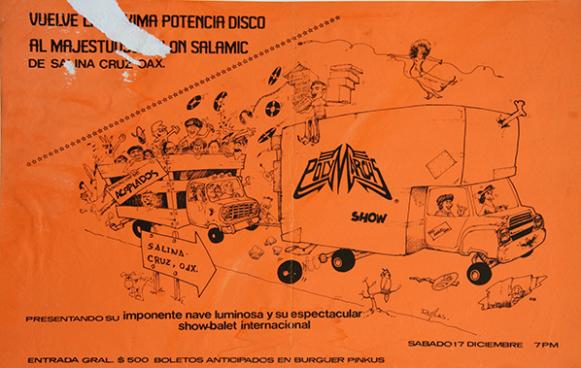
In the margin within – those more notorious neighborhoods of the Distrito Federal – embroidered logo jackets circulate, lending publicity to the sonidos along with their cards, posters, flyers, banners. Nonetheless, fewer and fewer dance parties are thrown. The city government has issued a discretionary ban of sonidero events in public spaces, canceling even traditional dances like the anniversary celebrations of Tepito’s markets. In the outer margins, ringing the DF and beyond, painted walls announce upcoming events and sonido trailers take over the streets. The dances go on.
We aren’t as familiar with the electronic scene, headed by Polymarchs. Our inroad is through the graphic materials comprising the collection Panther has amassed since 1979, which he rightly considers his primary asset. It all began in the Zona Rosa, where he used to go to trade posters, leaflets, stickers. At thirteen he formed part of the Polymarchs crew, coiling cables. Later he became a publicist, promoter, producer. He never stopped his gathering; stacks of paper tower in the office. Hundreds of posters and dozens of original drawings from the golden age of Hi-NRG pass in front of the camera, as José Luis remembers key scenes and events from this world: when they brought Gloria Gaynor to Mexico for the first time, when Sylvester came, when they packed the World Trade Center.
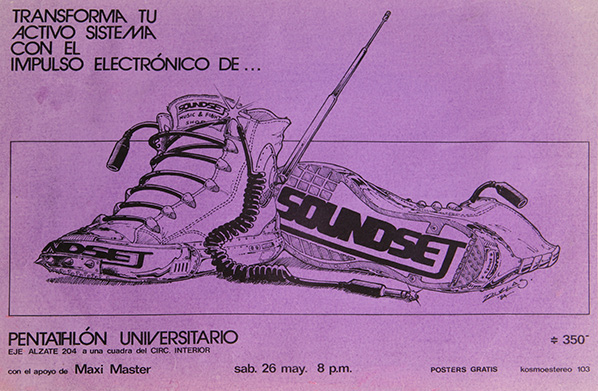
We are introduced to the world of artists and designers who created an imaginary to suit the precursors of the genre: pharaonic, galactic, utopian, spectacular, and futuristic. Always epic. Tailored to the moment, to the experience of the fans. The posters of the electronic sonidero movement are unique in format, employing unexpected techniques and materials; they are distinct, painstaking, sensational, new. In contrast, the works of tropical sonidos follow in the typographic vein of Mexico’s Gráfica Popular – reminiscent of the wrestling, taking the freedoms of the tropics, whether with box cutter or in full pixel. In the world of disco, Hi-NRG, and techno, the graphics are like the sound system: cult objects, concepts, myth.
“Do you want to meet Jaime Ruelas?” asks José Luis. The master of ink drawing, creator of logos and illustrations as iconic as La Changa or Polymarchs themselves. Of course we do. We are his fans, and we are an army. We arrive nearly punctually to the interview, with photography, audio and video gear in tow. Nearly punctually, because Jaime is already waiting; the son of a watchmaker, he knows machines, design and sound from the inside. He also knows the history of Polymarchs well, and from the beginning. Polymarchs’s first gig took place in his apartment in Tlatelolco. Later, Jaime became the sonido’s first DJ, before switching his focus to images.
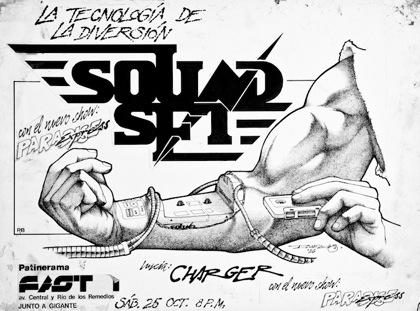
Like the sonidos thriving now in the capital, Polymarchs began in Puerto Ángel, on the Oaxaca coast, with a modest set-up – just a single Telefunken console and two baffles. The collective was formed by three siblings in 1975: Apolinar, Elisa and María de los Ángeles Silva Barrera. In 1978 they moved to Mexico City. Apolinar took charge of the sonido, and with Jaime Ruelas he discovered disco and Hi-NRG. The tenacity of Polymarches transcends mere selection of musical genres; the approach here is different. With tropical sonidos, the music, the equipment, the role of DJ and MC are the purview of one person, a single all-powerful figure operating from behind the console. Polymarchs is coming from somewhere else, assembling great towers of scaffolding, creating a spectacle, an experience, an environment. Neither DJ or MC, this is an entire machine. Polymarchs designs, produces and operates structures of light and sound as have never been seen before, radiant vessels that travel, carrying immense tech crews and companies of retro-futuristic dancers, from Tenochtitlan to outer space. There are explosions in the cosmos. On the floor all hands are up, cellphones by the thousands.
When Apolinar Silva and the Polymarchs team arrive at the Centro Cultural de España to give a conference in the context of the Proyecto de Gráfica Sonidera, the auditorium is brimming. Followers sport the distinctive t-shirts and jackets, hold up posters they’ve collected, wave cellphones. Apolinar is glowing; he is the supreme authority and, more than mythic, he is mystic. The audience takes the microphone to share their experiences. Like the time a Polymarchs event was organized in Mexico City’s Zócalo and what people thought was an earthquake turned out to be the earth shuddering under such dance. Below, in one of the exhibition spaces, Polymarchs set up a kind of black-light temple, aglow with, among many others, the visions we now share now with you.
The Proyecto de Gráfica Sonidera was an intensive program that resulted in records and research, specialized workshops and others for children, the painting of walls, the exhibition of graphic, photographic, and video material, and a series of talks along with book and documentary releases. We had the honor of including a drawing by Jaime Ruelas, and we kicked off with a dance party dedicated to Polymarchs… which was epic. There was a little boy who stole the dance floor, winning it against the odds from the more seasoned dancers.
All this was made possible thanks to many people and institutions. Shout-outs to the following generous collaborators: Marco Ramírez, José Luis Lugo, Javier Echavarría, Jaime Ruelas, Livia Radwanski, Mark Powell, Mirjam Wirz, Rocío Montoya, Tonatiuh Cabello, Diego Delgado, Alan Lazalde, Sonido Fajardo, Luis Sánchez, Héctor Rubí, Julio Díaz Corona, Sonido Leo, Christian Cañibe, Eduardo “Aníbal” Dueñas, Eleazar “Canuto” Escobar and the shop personnel of Publicidades Panther, Publicidades Lupano, Aisel Wicab, Citlali López Maldonado, Pedro Sánchez, Marisol Mendoza, Lupita La Cigarrita, Sonido Pío, Víctor Hernández, Edgar Ramírez, Laura Zárate, Griska Ramos, Mirna Roldán. Official respects to FONCA, to CONACULTA, to the Fundación Alumnos 47 and to the Centro Cultural de España.
Someone said to me ‘To you football is a matter of life or death!’
and I said ‘Listen, it’s more important than that’.
Bill Shankly
Drawing is one of the two oldest purely cultural – in the sense of playful, not directly concerned with keeping body and soul together like cooking or hunting or shelter – activities that comes down to us today directly in the form of artefacts from between 25 – 35 thousand years ago [1] (the other is music [2]). There is no known human culture that has not made representational and other marks with something, on something, for both fun and survival. Furthermore, as Patrick Maynard demonstrates in his steely eyed and magisterial Drawing Distinctions [3], it can be shown to be the practice which more than any other underpins not only all of present day visual culture (including photography, which, following Maynard [4], we read as a species of drawing) but also the technical developments of our advanced industrial age. With satisfying circularity, drawing, a fundamental tool for engineers and architects, scaffolds the level of production which (by guaranteeing surplus product) is the prerequisite for the very existence of our substantial caste of artists and designers, those useless and indispensable dreamers.
Arguably, then, in a perfect world its study might be counted, with literacy and numeracy, as a genuinely key skill to be studied by all. Certainly, perhaps a more realistic demand, it should be a practice both underpinning and overarching any systematic education in art and design. What concrete shape might this take within the Babel of practices which current art education encompasses?
A couple of years ago the two of us, both from a background in digital art/moving image, started teaching on two consecutive courses – a Foundation degree in Digital Art and Design and its top-up, a BA (Hons) degree in Art and Design Practice. Much of the formal documentation of the courses specified the use of particular kinds of software and allegedly real-world reasons for deploying them (many involving the demands of “industry”). From the start we were antagonistic to this approach. We wanted to “artify” the course – introduce as much experimental, speculative, exploratory, pleasurable and downright pointless (in the way that the best art is both pointless and hugely important) activity as possible. We didn’t abandon the idea of teaching design, but we did decide that the core course programme would henceforth be art/design agnostic – it would deal with ways of making and thinking about images (as well as sound, performance, interactions or concepts) that could be used with profit by students moving in either or both or other directions. It would not be training; work would be driven by the imagination and shaped by the ambitions of students. Teachers would introduce new technical processes, but these would be embedded in thematically organised investigations of historic and contemporary precedents. Help with technique or software might be part of what teachers did, but this would be part of an organic investigation/development by student and teacher together. If a teacher knew something they would help; if they didn’t, they might know where to look; if neither knew, they might search together; if the student knew, they could teach other students and the teacher too. In short we identified a peer-learning process as the only sensible approach sufficient for developing the necessary skills, knowledge and flair in a rapidly-developing field.
Moreover we wanted a course that integrated the digital with every other sort of visual (and conceptual, performative and sonic) practice. We were both impatient with the idea that work made using digital tools, or work created within and distributed across a network, was somehow qualitatively different from all that had preceded it (a not uncommon view often allied to a species of digital mysticism). Indeed we realised we both sensed, and gradually came to articulate clearly, that there was a continuum – a chain – from the cave painter to the contemporary artist. Not to say that social and historical concreteness plays no explicatory role, but that there is some still human centre to mark making (and to allied practices – singing, the telling of tales, etc.) which has persisted and will persist and is part of the territory of being human. ’A chain’ is no loose metaphor, but a precise account of the reality. Inspiration and technique pass continuously from generation to generation. And this is cumulative – making much of the past of art available to its future. In a sense the terrain of art accretes, expands, as time passes. Even what is lost to famine or war, proscription, taste and changes in technology leaves traces, the possibility of reconstruction and re-use (and, often most creatively, misuse). This is what we wanted to instil in our students.
Our drawing sessions link to and are inspired by earlier instances of art powered pedagogy that place cross-form conversation at the heart of learning together. Joseph Beuys made drawings throughout his artistic life – often enigmatic constellations of media, concepts, entities, political figurations and material properties. However of particular relevance here are his extended works, Office of the Organization for Direct Democracy by Popular Vote for 100 days at documenta 5, 1972 and Honey Pump in the Workplace for documenta 6 in 1977, in which he demonstrates his expanded notion of art that is exactly congruous with his philosophy of teaching – ‘to reactivate the “life values” through a creative interchange on the basis of equality between teachers and learners.’ [5] Both pieces required the involvement of many people in processes outside of the realms of ordinary action (such as the maintenance of the plastic pipes of the honey pump as it circulated 2 tonnes of honey through the building) in order that they might connect with unfamiliar concepts and experiences. The artworks integrated many different categories of work (some, but not all, associated with art making) including performance and the practice of various disciplines (of dialogue, rhetoric, democratic processes of exchange and decision making). And yet, in an interview with Achille Bonito Oliva, Beuys makes it clear that he has no interest leading audiences towards an “activism devoid of content” [6]. The liberation of humankind through art (Beuys proposes that everyone is an artist and society is to be sculpted by everyone) depends on a more deliberate engagement of individual energies.
Drawing was particularly important to both of us. It was something Ruth had always done from an early age. Collections of drawings made by her between the ages of six and thirteen depict public street scenes of everyday social groupings and activities (a group of kids running with a dog, two mothers with two prams, businessmen waiting for a bus). The figures are too small to carry facial expressions. Nevertheless their interactions, mood, social status and relationships are expressed by their outfits, gaits, their gestures and their proximity to each other and other elements of the scene. Ruth now looks back on these as evidence of an early growing fascination with sociality. Through school she learned that ‘drawing well’ meant producing an image as much like a photograph as one might render. Praise and grades were awarded accordingly. Later, at art school, drawing became a liberating process of discovery. She generated abstract marks, as traces of energies within the body, rather than to create a deliberate composition within a pictorial plane. In this way she produced surfaces such as might be produced by soot covered animals (think monkey, gazelle, seal, tiger, crow) thrown together into a white room. This surface would then serve as a mirror (or crystal ball) from which entities, gestures and forms of light and shadow emerged to be drawn out in further explorations of aspects of her unconscious.
Drawing was something that Michael aspired to. Because he had come to moving image work – to “being an artist” – by a strange route through theatre, maths and music, he had both a fascination with and a terror of drawing. He had been the kid in the class who couldn’t draw, and yet had loved the feeling, the deep engagement with both the act and with what it awoke inside him –his mind’s eye – that it brought. In his moving image work he had attempted to confront this. The inverted commas that came with a certain species of conceptualism were a great help because he could frame himself performatively, comically almost, as an uncertain but oh-so-willing draftsperson, one with no eye or dexterity, a technical schlemiel.
In his secret heart, though, he knew he wanted to do this thing without (or at least largely without) irony.
Arising out of this obsession, in the early years of the new millennium, Michael had launched a little provocation where he challenged digital artists, as they were then still called, to create self-portraits, on the sole condition that this be done using non-digital means, and subsequently to photograph them for display in an online archive. Those who didn’t baulk at the task produced a touching and intriguing panorama, of pen and paint and pencil but also of bathroom tile, egg tempera and iron filings… [7]
As part of a discussion about this Michael had opined on some listserv or other that the barriers between artistic practices were porous and that the true measure of anyone aspiring to be an artist (musician, film maker, poet) was that, if lost in a deep forest or desert isle, with only a rock to make some marks on and another rock to make those marks with, the putative artist would eventually produce something of interest, depth and value.
Early on we introduced chunks of drawing as an occasional workshop – Ruth introduces, and then builds on familiar art school, Bauhaus type exercises that attempt to separate process from outcome-anxiety, allowing students to engage with an inner dialogue about their looking and representation un-disrupted by fears of inadequacy. These include:
drawing without looking at the paper; from memory; without removing pencil from paper; drawing with the “wrong” hand; drawing in five minutes or five seconds; drawing only negative space; having the pencil trace the movement of the eyeball as the drawer observes an object, etc.
Michael felt the centrality of drawing calling him but these sessions still felt like a slightly naughty holiday, an activity that did not necessarily link to his background and formation as an artist. The teacher, like the student, was still exploring.
The big epiphany came with the introduction of a weekly drawing session for all three years of the course. It happened and happens every Monday of term, without fail, and everyone in the room takes part, staff included. As many days as possible where more than one member of staff is present in the room, to make for debate, thus modelling civilised disagreement and forcing students, ultimately, to make up their own minds; there are usually two members of staff and occasionally more present. Each drawing session is led by a student who brings in an object, procedure or puzzle for the rest of us to address.
What happened is that we were rapidly out-Bauhaused by our students. Byzantine sets of instructions for tasks that we as teachers would have rejected out of hand as overly complex, impractical or confusing were carefully explained by students and then carried out by all of us in utter silence.
Half an hour elapses, we place our sets of images on the floor and we process around them all, discussing them. The important thing is that everyone has drawn. Everyone is both vulnerable and admirable. Teachers are not privileged. For students, it is understood that although the process carries course credit, what is being marked eventually is a series of drawings – some “good”, some “bad”, most neither – and that technique – whatever that is – is not the focus. There must be room for play in creative education; hence, for this part of the course, taking part in all of the sessions is enough to secure a pass.
With respect to collective feedback, our experience has been that perceptive kindness predominates. We search for the wonderful things, speculating on why they are wonderful, maybe asking questions of the person who has made this thing, trying to elicit that week’s secret or lesson. The drawings are a pleasure to behold. We have no intention of reproducing any of them here, though many would bear reproduction – we do not want to betray the egalitarian, labouring-together ethos of the thing by selecting outside the sessions and group. We are not sentimentalists – it is precisely because we understand the necessary element of brutality involved in the fair administration of an assessed course that we want to create oases, visions of how things could be other. It is the collective production of shared work that matters – it is not, let us emphasise though, a privileging of “process over production”. The production matters – desperately so. [8]
Over the weeks, our drawings are diverse in category, style, media and technique including: illustrations of the set task, abstractions, naïve figurations, diagrams, signs; some are performances of processes made in pencil, pen, paper, wood, charcoal, paint, collage, arrangements of plastic objects, paper-constructions; they reveal our choices and learning. Some students advance arguments in their drawings either with each other or with their own earlier work. As new tasks are set we each decide in the moment whether we understand the activity we are to involve ourselves with is mundane, ritualistic (perhaps even sacred), mad or wise, pointless or significant – our conclusions shape our drawings. In this way collective drawing has become central to the ethos of our courses as an integrative practice for negotiating a shared studio culture and shaping our learning together, our movement towards collegiality. Doing the drawing means the week has a start to it – we affirm ourselves as folk with a common interest, different but equal. The sessions have helped to provide a social glue, too, across the three years of the course.
There are areas where we as teachers know more than the students; both of us have track records of work in the art world, but the drawing sessions level us all – they enable a mutually supportive but acute look at progress on a common task. Since the drawing started we have also incorporated its lessons to other disciplines; staff and students share their photography work in a more horizontal way than the demands of the course would normally allow. We use new forms of social media, and have Flickr accounts in which all participants are contacts.[9] We comment on and “favourite” each other’s works as equals and collaborators.
Both drawing and photography in these contexts devolve to something similar – filling a blank space by mark making, with valuable, experiential knowledge accrued: repeating processes many times over to find out what constitutes skill and when (often, it turns out, much more often than is often acknowledged) to accept the gifts brought by chance; discovering that the art happens in a social space between the maker, the wider world and the viewer; understanding the work of others because we do it side by side; and, finally, coming to grips with the question of personal style and the diversity of ways of doing things well and meaningfully.
Each week reveals both artistic phylogeny and ontogeny – we solve the problem here and now, as if for the first time ever and this illuminates the historical chain, the intertwining of theory and practice, our mutual dependence, all of us artists and all of us nourished by art too.
—-
Originally written for Drawing Knowledge (2012). Tracey, The Journal of Drawing and Visualisation Research, Loughborough University.
Revised and republished Miller, A & Strong, J. (eds). (2012) Research-Led and Research-Informed Teaching. CREST Publishing.
Michel Bauwens is one of the foremost thinkers on the peer-to-peer phenomenon. Belgian-born and currently resident in Chiang-Mai, Thailand, he is founder of the Foundation for P2P Alternatives.
It’s a commonplace now that the peer-to-peer movement opens up new ways of creating relating to others. But you’ve explored the implications of P2P in depth, in particular its social and political dimensions. If I understand right, for you the phenomenon represents a new condition of capitalism, and I’m interested in how that new condition impacts on the development of culture – in art and also architecture and urban form.
As a bit of a background, I’d like to look at what you’ve identified as the simultaneous “immanence” and “transcendence” of P2P: it’s interdependent with capital, but also opposed to it through the basic notion of the Commons. Could you elaborate on this?
With immanence, I mean that peer production is currently co-existing within capitalism and is used and beneficial to capital. Contemporary capitalism could not exist without the input of free social cooperation, and creates a surplus of value that capital can monetize and use in its accumulation processes. This is very similar to coloni, early serfdom, being used by the slave-based Roman Empire and elite, and capitalism used by feudal forces to strengthen their own system.
BUT, equally important is that peer production also has within itself elements that are anti-, non- and post-capitalist. Peer production is based on the abundance logic of digital reproduction, and what is abundant lies outside the market mechanism. It is based on free contributions that lie outside of the labour-capital relationship. It creates a commons that is outside commodification and is based on sharing practices that contradict the neoliberal and neoclassical view of human anthropology. Peer production creates use value directly, which can only be partially monetized in its periphery, contradicting the basic mechanism of capitalism, which is production for exchange value.
So, just as serfdom and capitalism before it, it is a new hyperproductive modality of value creation that has the potential of breaking through the limits of capitalism, and can be the seed form of a new civilisational order.
In fact, it is my thesis that it is precisely because it is necessary for the survival of capitalism, that this new modality will be strengthened, giving it the opportunity to move from emergence to parity level, and eventually lead to a phase transition. So, the Commons can be part of a capitalist world order, but it can also be the core of a new political economy, to which market processes are subsumed.
And how do you see this condition – the relationship to capital – coming to a head?
I have a certain idea about the timing of the potential transition. Today, we are clearly at the point of emergence, but also coinciding with a systemic crisis of capitalism and the end of a Kondratieff wave.
There are two possible scenarios in my mind. The first is that capital successfully integrates the main innovations of peer production on its own terms, and makes it the basis of a new wave of growth, say of a green capitalist wave. This would require a successful transition away from neoliberalism, the existence of a strong social movement which can push a new social contract, and an enlightened leadership which can reconfigure capitalism on this new basis. This is what I call the high road. However, given the serious ecological and resource crises, this can at the most last 2-3 decades. At this stage, we will have both a new crisis of capitalism, but also a much stronger social structure oriented around peer production, which will have reached what I call parity level, and can hence be the basis of a potential phase transition.
The other scenario is that the systemic crisis points such as peak oil, resource depletion and climate change are simply too overwhelming, and we get stagnation and regression of the global system. In this scenario, peer-to-peer becomes the method of choice of sustainable local communities and regions, and we have a very long period of transition, akin to the transition at the end of the Roman Empire until the consolidation of feudalism during the first European revolution of 975. This is what I call the low road to peer to peer, because it is much more painful and combines both progress towards p2p modalities but also an accelerating collapse of existing social logics.
That’s a less optimistic scenario… what form of conflict would this involve?
The leading conflict is no longer just between capital and labour over the social surplus, but also between the relatively autonomous peer producing communities and the capital-driven entrepreneurial coalitions that monetize the commons. This has a micro-dimension, but also a macro-dimension in the political struggles between the state, the private sector and civil society.
I see different steps of political maturation of this new sphere of peer power. First, attempts to create networks of sympathetic politicians and policy-makers; then, new types of social and political movements that take up the Commons as their central political issue, and aim for reforms that favour the autonomy of civil society; finally, a transformation of the state towards what I call a Partner State which coincides with a fundamental re-orientation of the political economy and civilization. You will notice that this pretty much coincides with the presumed phases of emergence, parity and phase transition.
Most likely, acute conflict may arise around resource depletion and the protection of these resources through commons-related mechanisms. Survival issues will dictate the fight for the protection of existing commons and the creation of new ones.
You often cite Marx, who of course also wrote at a time of conflict and social change provoked by technological and economic development. Does this tension you’re describing fit in his notion of contradictory forces conflicting – thesis, antithesis, synthesis – in other words, is this a historical materialist process?
I don’t quite use the same language, because I use Marx along with many other sources. I never use Marx exclusively or ideologically, but as part of a panoply of thinkers that can enlighten our understanding. My method is not dialectical but integrative, i.e. I strive to integrate both individual-collective aspects and objective-subjective aspects, and to avoid any reductionist and deterministic interpretations. Though I grant much importance to technological affordances, I do not adhere to technological determinism, and I don’t find that I pay much attention to historical materialism, since I see a feedback loop between culture, human intentionality, and the material basis. Technology has to be imagined before it can be invented.
My optimism is grounded in the hyperproductivity of the new modes of value creation, and on the hope that social movements will emerge to defend and expand them. If that fails to happen, then the current unsustainable infinite growth system will wreak great havoc on the biosphere and humanity.
As you say classical or Marxist economics don’t really suffice to describe the current situation. Is one aspect of this problem that the classical distinction between use and exchange doesn’t fit with a situation in which many of the “uses” are ludic, and have an exchange system built into them? I’m thinking of on-line gaming specifically. But it has always been difficult to place art in this simple use/exchange polarity. Do you see any revisions to that polarity today?
I’m not sure the ludic aspect is crucial, as use value is agnostic to the specific kind of use, just as peer production is agnostic as to the motivation of the contributors. However, our exponential ability to create use value without intervention of the commodity form, with only a linear expansion of the monetization of peer platforms, does create a double crisis of value. On the one hand, capital is valuing the surplus of social value through financial mechanisms, and is not restituting that value to labour, just as proprietary platforms do not pay their value producers; on the other hand, peer producers are producing more and more that can’t be monetized. So we have financial crisis on the one hand, a crisis of accumulation and a crisis of precarity on the other side. This means that the current form of financial capitalism, because of the broken feedback loop between value creation and realization, is no longer an appropriate format.
Regarding your ‘integrative method’, this is a much more sophisticated take on economics that places it in relationship to other, cultural, dimensions of human life. And the imagination is central to it. Given that, do you see any special role for art in this transition?
Art is a precursor of the new form of capitalism, which you could say is based on the generalization of the ‘art form of production’. Artists have always been precarious, and have largely fallen outside of commodification, relying on other forms of funding, but peer production is a very similar form of creation that is now escaping art and becoming the general modality of value creation.
My take is that commodified art has become too narcissistic and self-referential and divorced from social life. I see a new form of participatory art emerging, in which artists engage with communities and their concerns, and explore issues with their added aesthetic concerns. Artists are ideal trans-disciplinary practitioners, who are, just as peer producers, largely concerned with their ‘object’, rather than predisposed to disciplinary limits. As more and more of us have to become ‘generally creative’, artists also have a crucial role as possible mentors in this process. I was recently invited to attend the Article Biennale in Stavanger, Norway, as well as the artist-led herbologies-foraging network in Finland and the Baltics, and this participatory emergence was very much in evidence, it was heartening to see.
We might see as opposed to that sort of grassroots participatory engagement, the entities you refer to as the “netarchies.” Their power lies in the ownership of the platform they exploit for harvesting user-originating information and activities. How hegemonic is this ownership? At what point does it become impossible to create a “counter-Google”?
The hegemony is relative, and is stronger in the sharing economy, where individuals do not connect through collectives and have weak links to each other. The hegemony is much weaker in the true commons-oriented modalities of production, where communities have access to their own collaborative platforms and for-benefit associations maintaining them.
The key terrain of conflict is around the relative autonomy of the community and commons vis a vis for-profit companies. I am in favour of a preferential choice towards entrepreneurial formats which integrate the value system of the commons, rather than profit-maximisation. I’m very inspired by what David de Ugarte calls phyles, i.e. the creation of businesses by the community, in order to make the commons and their attachment to it viable and sustainable over the long run. So, I hope to see a move from the current flock of community-oriented businesses, towards business-enhanced communities. We need corporate entities that are sustainable from the inside out, not just by external regulation from the state, but from their own internal statutes and linkages to commons-oriented value systems.
Counter-googles are always possible, as platforms are always co-dependent on the user communities. If they violate the social contract in a too extreme way, users can either choose different platforms, or find a commons-oriented group that develops an independent alternative, which in turn maintains the pressure on the corporate platforms. I expect Google to be smart enough to avoid this scenario though.
As you’ve said elsewhere, many of these issues are about a new form of governance. Do you see any of this as particularly urban in character — I mean, about organization at the smaller scale, regionally focused, as opposed to at the level of the nation state. Does propinquity matter at all to this — the importance of living together? This seems to relate to a — not a contradiction or tension exactly, but a complication of the P2P notion — that relationships are dispersed, yet a number of the parallels you draw with historical models (for example the Commons) connect with social situations in which people lived very close together. A fairly strong notion in urbanistic thinking is that propinquity is a good thing. In the past that was part of many artistic relationships also: cities as milieux of artistic production/creativity, artists’ colonies; working cheek by jowl with other creative people and breathing the same air. Is this notion in any sense undermined by dispersed networks?
I think we are seeing the endgame of neoliberal material globalization based on cheap energy, and hence a necessary relocalization of production, but at the same time, we have new possibilities for online affinity-based socialization which is coupled with resulting physical interactions and community building. We have a number of trends which weaken the older forms of socialization. The imagined community of the nation-state is weakening both because of the globalized market; the new possibilities for relocalization that the internet offers, which includes a new lease of life to mostly reactionary and more primary ethnic, regional and religious identities; but also because of this important third factor, i.e. socialization through transnational affinity based networks.
What I see are more local value-creation communities, but who are globally linked. And out of that, may come new forms of business organization, which are substantially more community-oriented. I see no contradiction between global open design collaboration, and local production, both will occur simultaneously, so the relocalized reterritorialisation will be accompanied by global tribes organized in ‘phyles.’ I think the various commons based on shared knowledge, code and design, will be part of these new global knowledge networks, but closely linked to relocalized implementations.
One interesting question is what forms of urbanism come out of p2p thinking. The movement is in the process of thinking this through, in fact a definition of p2p urbanism was just published by the “Peer-to-peer Urbanism Task Force” (http://p2pfoundation.net/Peer-to-Peer_Urbanism).
This promotes, in general terms, bottom-up rather than centrally planned cities; small-scale development that involves local inhabitants and crafts; and a merging of technology with practical experience. All resonant in various ways with p2p approaches. But this statement also provokes a few questions: It calls for an urbanism based on science and function; in fact it explicitly promotes a biological paradigm for design. At the risk of over-categorizing, isn’t this a modernist understanding of design — or if not, how is it different? This document also refers to specific schools of urban design: Christopher Alexander, and also New Urbanism. On the side of socio-economics though, New Urbanism has been criticized (for example in David Harvey’s Spaces of Hope); some see it as nostalgic and in the end directed at a narrow segment of the population. Christopher Alexander’s work on urban form has also been criticized as, being based on consensus, restrictive in its own ways. In fact, might not p2p principals call for creation of spaces that allow dissent and even shearing-off from the mainstream? Might there be a contradiction built into trying to accommodate the desires for consensus and for freedom? Contradiction can be a source of vitality, certainly in art; but it can raise some tensions when you get to built form and a shared public realm.
I cannot speak for the bio- or p2p urbanism movement, which is itself a pluralistic movement, but here’s what I know about this ‘friendly’ movement. I would call p2p urbanism not a modernist but a transmodernist movement. It is a critique of both modernist and postmodern approaches in architecture and urbanism; takes critical stock of the relative successes and failings of the New Urbanist school; and then takes a trans-historical approach, i.e. it critically re-integrates the premodern, which it no longer blankly rejects as modernists would do. I don’t think that makes it a nostalgic movement, but rather it simply recognizes that thousands of years of human culture do have something to teach us, and that even as we ‘progressed’, we also lost valuable knowledge. Finally, I think there is a natural affinity between the prematerial and post-material forms of civilization. The accusation of elitism is I think also unwarranted, given what I know of the work of bio-urbanists amongst slumdwelling communities. However, I take your critique of consensus very seriously, without knowing how they answer that. You are right, that is a big danger to guard for, and one needs to strive for a correct balance between agreed-upon frameworks, that are community and consensus-driven, and the need for individual creativity and dissent. Nevertheless, compared to the modernist prescriptions of functional urbanism, I don’t think that danger should be exaggerated.
Following on this track, I’d like to pose another question that relates to living together. The P2P concept depends on the difficulty of controlling the activity of peers on a network: i.e. it’s impossible to lock down the internet. Doesn’t this degree of freedom also eliminate those social controls that might be considered “healthy” – for example, controls over criminal activity. David Harvey (to bring him in again), in his paper “Social Justice, Postmodernism and the City”, lists social controls among several elements of postmodern social justice. When the grand narratives have been replaced by small narratives, there remains a need to limit some freedoms. How does p2p thinking deal with this?
I think we can summarize the evolution of social control in three great historical movements. In premodern times, people lived mostly in holistic local communities, where everyone could see one another, and social control was very strong. At the same time, vis a vis more far-away institutions, such as for example the monarchy, or the feudal lord, or say in more impersonal communities such as large cities, compliance was often a function of fear of punishment. With modernity, we have a loss of the social control through the local community, but a heightened sense of self through guilt, combined with the fine-grained social control obtained through mass institutions, described for example by Michel Foucault. The civility obtained through the socialization of the imagined community that was the nation state, and the educational and media at its disposal, also contributed to social control and training for civil behaviour.
My feeling about peer-to-peer networks is that they bring a new form of very real socialization through value affinity, and hence, a new form of denser social control in those specific online communities which also usually have face-to-face socialities associated with them. But this depends on whether the community has a real value affinity and a common project, in which case I think social control is ‘high’, because of the contributory meritocracy that determines social standing. On the contrary, in the looser form of sharing communities, say YouTube comments for example, we get the type of social behaviour that comes from anonymity and not really being seen.
So the key challenge is to create real communities and real socialization. Peer to peer infrastructures are often holoptical, i.e. there is a rather complete record of behaviour and contributions over time, and hence, a record of one’s personality and behaviour. This gives a bonus to ‘good ethical behaviour’ and attaches a higher price to ‘evil’. On the other hand, in the looser communities, subject to more indiscriminate swarming dynamics, negative social behaviour is more likely to occur.
A key difference between contemporary commons and those of the past is that the new ones are immaterial and global. The model for P2P exchange seems to be of autonomous agents relating and forming new communities not based on membership in an originary cultural group. Given a global distribution, how do local, cultural factors play into the model of globalized distributed networks? How does P2P accommodate cultural specificity, especially specificity with deep historical roots; and how does that accommodate the development of new culture, art?
In my view, the digital commons reconfigure both the local and the global. I think we can see at least three levels, i.e. a local level, where local commons are created to sustain local communities, see for example the flowering of neighbourhood sharing systems; then there are global discourse communities, but they are constrained by language; so rather than national divisions, which still exist but erode somewhat as a limitation for discourse exchange, there is a new para-global level around shared language. At each level though, cultural difference has to be negotiated and taking into account. If there is no specific effort at diversity and inclusion, then affinity-based communities reproduce existing hierarchies. For example, the free software world is still dominated by white males. Without specific efforts to make a dominant culture, which has exclusionary effects, adaptive to inclusion, deeper participation is effectively discouraged. Of course, as the dominant culture may not be sufficiently sensitive, it is still incumbent on minoritarian cultures to make their voice and annoyances heard. Obviously, each culture will have to go through an effort to make their culture ‘available’ through the networks, but I think the specific role of artists, now operating more collectively and collaboratively than before, is to experiment with new aesthetic languages, so that non-conceptual truths can be communicated.
The innovation I see as most important though is in terms of the globa-local, i.e. a relocalization of production, but within the context of global open design and knowledge communities, probably based on language. I also see a distinct possibility for a new form of global organization, i.e. the phyle I mentioned earlier, as fictionalized in Neal Stephenson’s The Diamond Age and operationalized by lasindias.net. These are transnational value communities that created enterprises to sustain their livelihoods.
I see the key challenge, not just to develop ‘relationality’ between individuals, as social networks are doing very well, but to develop new types of community, such as the phyle, which are not just loose networks, but answer the key question of sustainability and solidarity.
In terms of culture, what I see developing is a new transnational culture, based on value and discourse communities, based on language, that are neither local, nor national, nor fully cosmopolitan, but ‘trans-national’.
And the creative relationships between artists can in some sense be a model for this?
Artists have been precarious in almost all periods of history, and their social condition reflects what is now very common for ‘free culture’ producers today, so studying sustainability and livelihood practices of artist communities seems to me to be a very interesting lead in terms of linking with previous historical experience. I understand that artists now have increasingly collaborative practices and forms of awareness. Unfortunately, my own knowledge of this is quite limited so this is really also an open appeal for qualified researchers to link art historical forms of livelihood, with current peer production. In some ways, we are all now becoming precarious artists under neoliberal cognitive capitalism!
In 2002, when Monochrom was invited to act as the representative of Austria at the Sao Paulo Biennial, instead of going as yourselves, you sent Georg Paul Thomann, one of the country’s most prominent avant guard artists, and also a complete fabrication.
Yes, we were asked to represent the Republic of Austria at the Sao Paulo Art Biennial, Sao Paulo (Brazil) in 2002. However, the political climate in Austria (at that time, the center-right People’s Party had recently formed a coalition with Jorg Haider’s radical-right Austrian Freedom Party) gave us concerns about acting as wholehearted representatives of our bloody nation. We dealt with the conundrum by creating the persona of Georg P. Thomann, an irascible, controversial (and completely fictitious) artist of longstanding fame and renown. Through the implementation of this ironic mechanism – even the catalogue included the biography of the non-existent artist – we tried to solve with pure fiction the philosophical and bureaucratic dilemma attached to the system of representation.
It gave me something of a hearty guffaw to hear about how you and your fellows, manning the Austria country booth as the artist’s technical support staff – the lowliest of low in the art world hierarchy – went about revealing the fictitious nature of the artist.
Yes, we turned the tables. When members of the administration, journalists, or curators asked about the whereabouts of Thomann, our irritated answer was that he hadn’t cared to show up so far, and that he hadn’t helped with anything, because he was supposedly watching porn in his hotel room all day, while we – the members of his technical crew – didn’t care about that bullshit at all. But we informed other technical support teams about the basic idea of the project. They were also given detailed information about Thomann’s non-existence but we did not give them any hierarchic directives about what to do with their knowledge but left it up to them if they wanted to reveal the fake or keep spinning the story. Most people enjoyed doing the latter and they also kept telling different versions of the heard information until finally a bubbling geyser kept erupting in various ways and constantly led to new outbreaks of tittle-tattle.
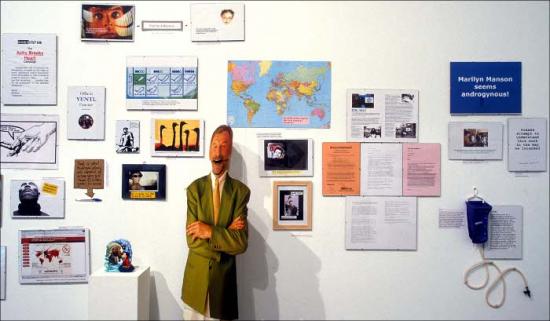
What happened next, as I heard you describe it, was that “bubbles and bubbles of rumors” began to form around the expansive floor of the biennial. I found this moment in the arc of the project to be particularly interesting and was hoping you could perhaps share some of your thoughts and recollections.
Let’s give you a brief summary of the background. The basic principles of an art-super-structure like a Biennial is simple: lots of little white boxes in which art was set up – and little artists, spreading business cards like prayers. There is a nice German term: “die Warenformigkeit des Kunstlers” (“the commodity value of the artist”). We hardly had any contact with other artists… and that was bad. They came from more than 80 different countries, but they were hiding in their white boxes. Everyone was busy building his or her own little world. Then, during the final setup phase we found out about an incident, which took place in our neighborhood through a copied note.
One year before the Biennial, Chien-Chi Chang had been invited to be the official representative of Taiwan at the Biennial. But then, three days before the opening, his caption – adhesive letters – had been removed from his cube virtually over night. ‘Taiwan’ was replaced with ‘Museum of Fine Arts Taipeh.’ But to Chien-Chi Chang the status as an official representative of Taiwan was very important, because his photography artwork dealt directly with the inhumane psychiatric system in Taiwan.

Chien-Chi was trying to get in contact with the Biennial administration and the chief curator (the German Alfons Hug), but didn’t succeed. Communication was refused. After that he decided to write an open letter, but the creative inhabitants of all the little white art-combs didn’t seem too interested in the artist’s chagrin, who by now wanted to leave the Biennial out of protest.
We were interested in the situation and did some research. We found out that the Chinese delegation had threatened to withdraw their contribution and to cause massive diplomatic problems. To them, Taiwan was clearly not an independent country (c/f ‘One China Policy’) and they put pressure on the Biennial management to get that message out. The management did not make this international scandal public and it was quite obvious why.
monochrom decided to show solidarity with Chien-Chi. We wanted to set an example and show that artists do not necessarily have to internalize the fragmentation and isolation that is being imposed upon them by the structure of the art market, the exhibition business, as well as the economy containing them. For us, though, this is not about taking a stand for either the westernized-economical imperialism represented by Taiwan or for China’s old-school Stalinist imperialism. This is about integrity and solidarity, values that we chose to express through a collaborative act. Together with other artists from various countries we launched a solidarity campaign: we took off some adhesive letters of each collaborating country’s signature and donated them to Chien-Chi Chang. monochrom sponsored the ‘t’ of Austria, while the Canadians donated one of their three as. The other participating artists were from Croatia, Singapore, Puerto Rico and Panama. A lot of artists and curators from other countries refused to support the campaign for fear of – as they would call it – “negative consequences.” WTF? But at least some of the artists were pulled out of their self-referential and insular national representation cubes which, in themselves, so rigorously symbolized the artists’ work and his or her persona as commodities.

After some time we managed to attach a trashy, yet legible ‘Taiwan’ to the outside wall of Chien-Chi Chan’s cube. Numerous journalists took notice of the campaign and Chien-Chi opened his exhibition in front of a cheering audience. Some days later, we found out that Chinese and Taiwanese newspapers massively covered the campaign. One Taiwanese paper used the headline “Austrian artist Georg Paul Thomann saves ‘Taiwan’.” In other words, a non-existing artist saved a country pressed into non-visibility. Who said that postmodernism can’t be radical?
What was it like – even from a kind of phenomenological sense – to be in the midst of this bubbling, to experience the formation of a scandal from its very embryonic moments? Is there something in the interiority of situations like this that you see as essential to the creation of new kinds of solidarity?
First we would have to define what “new kinds of solidarity” mean. What would be the ‘new’ part of it? Does it go beyond old and traditional forms of solidarity? And why should it? I think that classic forms of solidarity were carried out by political groups or other collective entities. They tried to express their (let’s label it as) “old-school solidarity” by pointing their collective fingers at someone who they thought were mistreated: “Look, look this human being is being oppressed!” And they always did it “in the name of something”. Old-school solidarity was one more frickin’ medium that people used to get a message across. Thus it was always part of the realm of representation. Your act of solidarity represents the one you show solidarity with, but your act is also advertisement for yourself, your cause and the (political) identity you wish to construct. Politics is always drama. Best example for this would be the “supporters of Palestine”. There are tons of ethnic groups on this rusty little planet who have to suffer under worse conditions. But nobody seems to be interested in showing solidarity with them. Where are Henning Mankell and Noam Chomsky when you really need them? Involved in some stupid fast-food anti-imperialism. We have to understand that the “object of solidarity” is something you pick for a reason… and most of the time it’s to feel good as a group and to impress your peers. But that has nothing to do with factual, non-reductionist political analysis. Collective entities define themselves through acts of representation and this representation is comparable to the construction of national pride or patriarchal family structures and values. Solidarity can be read as an act of defining identities. And that can be very dangerous, because old school solidarity always wants to be “right”. You are always “the good one” supporting the poor bastards. Smash dichotomies!
What we experienced at the Biennial of Sao Paulo back in the spring of 2002 was a very non-collective act. We were no real group, no leaflets, we had no common agenda, we were a psycho-geographic swarm. There was no basis for acting or speaking as a collective and there was no need to bundle our powers or form an identity. Yes, we tried to recruit other artists to join in our little act of solidarity. But it was no protest, we didn’t protest a certain political agenda because we didn’t want to end up in the old black and white world that, for example, all the apeshit Pro-Tibet supporters live in. Bah! Their ugly flags! Their patriarchal projections! Richard Gere! Yuck! So it was a kind of “free flowing solidarity”, not to be abused to form a political movement or statement. The only form of identity that was formed was the simple idea that even bourgeois artists can decide whether they want to be part of the Biennial and its stupid rules or whether they want to be part of action and fun.
To make it short: we are interested in micro-political solidarity, temporary solidarity that can’t fossilize. Solidarity is important if it can evolve and vanish within a short span of time and all that’s left is rumors and vague commemorations. Let’s call it a process of counteracting – that might be well-known in the field of the urban guerrilla but that so rarely pops up at art shows.
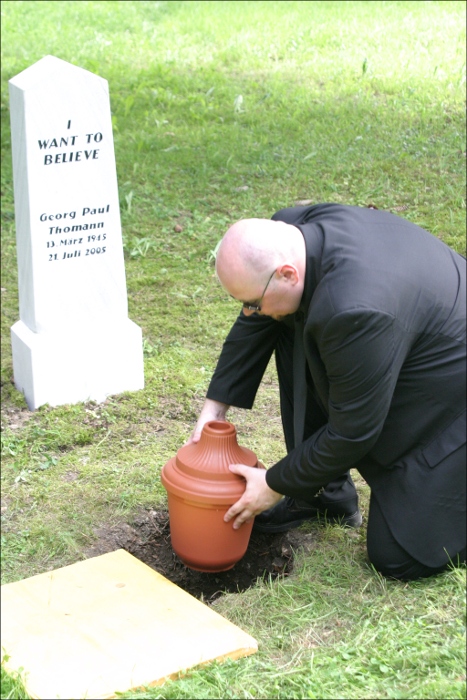
Read Part 1 of the Interview
http://www.furtherfield.org/interviews/interview-johannes-grenzfurthner-monochrom-part-1
Read Part 3 of the Interview
http://www.furtherfield.org/features/interviews/interview-johannes-grenzfurthner-monochrom-part-3
Above image taken by Scott Beale, Laughing Squid.
Marc Da Costa interviews the ever dynamic Johannes Grenzfurthner, founder of monochrom. This is the first of three interviews, where he talks about the project ‘Soviet Unterzoegersdorf’; the fake history of the “last existing appanage republic of the USSR”. Created to discuss topics such as the theoretical problems of historiography, the concept of the “socialist utopia” and the political struggles of postwar Europe. In March 2009 Monochrom presented ‘Soviet Unterzoegersdorf: Sector II’. The game features special guest appearances of Cory Doctorow, Bruce Sterling, Jello Biafra, Jason Scott, Bre Pettis and MC Frontalot.
Since 1993, the Monochrom members have devoted themselves to the grey zones where systems intersect: the art (market), politics, economics, pop, gaiety, vanity, good clean fanaticism, crisis, language, culture, self-content, identity, utopia, mania and despair. The technique underlying Monochrom’s work is that of being and working in the fields of Pop/avant-garde, theory/reflection, interventionism/politics, gaiety/lust/tragedy, (self-)configuration/mystification. The project Monochrom pushes into and beyond these fields is, ‘networking’ events, people, possibilities, material, impetus and identities.” (Zdenka Badovinac, Moderna Galerija Ljubljana)
Grenzfurthner has collaborated with groups such as ubermorgen, Billboard Liberation Front, Esel and Mego (label). Grenzfurthner writes for various online/print magazines and radio stations (e.g. ORF, Telepolis, Boing Boing). Grenzfurthner has served on a number of art juries (e.g. Steirischer Herbst, Graz). He holds a professorship for art theory and art practice at the University of Applied Sciences, Graz, Austria and is a lecturer at University of Arts and Industrial Design in Linz, Austria.
Recurring topics in Johannes Grenzfurthner’s artistic and textual work are: contemporary art, activism, performance, humour, philosophy, sex, communism, postmodernism, media theory, cultural studies, popular culture studies, science fiction, and the debate about copyright.
The ‘Soviet Unterzoegersdorf’, a game created by monochrom, is described as being at once the “last existing appendage republic of the USSR” and located inside the Republic of Austria. Could you speak a bit about the project and its background?
From a conceptual background we have to state that we have been occupied with the construction, analysis and reflection of alternative worlds for quite a long time. A lot of our projects are treating this field partly as a discussion with concepts deriving from popular culture, science and philosophy, and partly as a direct reference to science fiction and fantasy fan culture. We first created the fake history of the “last existing appendage republic of the USSR” in 2001 — ten years after the ‘mighty Soviet Union’ went into this nation-state-splitting-up-process and new countries emerged like Firefox pop-ups that you can’t manage to click away.
We wanted to discuss topics such as the problems of historiography, the concept of “utopia” and “socialist utopia” and the political struggles of postwar Europe in a playful, grotesque way. You have to bear in mind that the real village of Unterzoegersdorf was part of the Post WWII Soviet zone from 1945 until the foundation of the ‘neutral’ Republic of Austria in 1955. Reactionary Austrians talk about 1955 as the ‘real liberation’… and I have to mention that that’s rather typical: cheering when Hitler arrives and being proud members of the Third Reich, afterwards proclaiming that Austria was the first victim of Nazi Germany and complaining about the allied occupation forces — especially the Soviet.
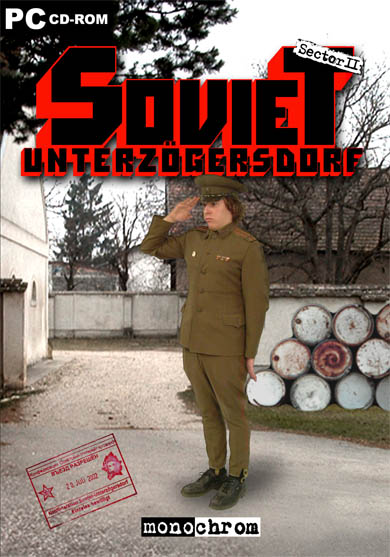
We transformed the theoretical concept into an improvisational theatre/performance/live action role-playing game that lasted two days. That means we really organized bus tours to Unterzoegersdorf — a small village that really exists — and acted the setting; beginning with the harsh EU Schengen border control. Later, in 2004, we started to think about a possible sequel to the performance. We thought that the cultural format of the “adventure game” provided the perfect media platform to communicate and improve the idea.
We started to work in February 2004 and presented ‘Sector 1’ — the first part of the trilogy — in the form of an exhibition in Graz/Austria in August 2005. We released ‘Sector 2’ in 2009, featuring guest stars as Cory Doctorow, Jello Biafra or Bruce Sterling. As the game series uses a 3rd person perspective with photo backgrounds and pictures of real actors as sprites, it took us quite a while to digitize and image process all of the material. This technique was actually first used by Sierra On-Line during the early and mid-1990s — but we are quite proud that we managed to get the feeling of discovering an old computer game that never existed on your old 500 MB hard drive. One aspect of the game is playing with memories and the future of the past. The future is a kind of carrot, the sort tied just in front of the cartoon donkey’s nose so it goes to work, goes off to war, learns Javascript and knows which bits to laugh at in Woody Allen’s Sleeper. You can imagine.
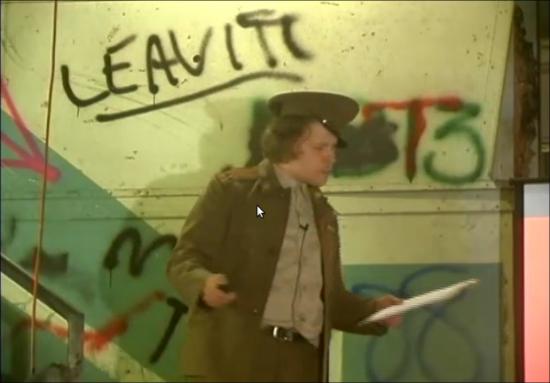
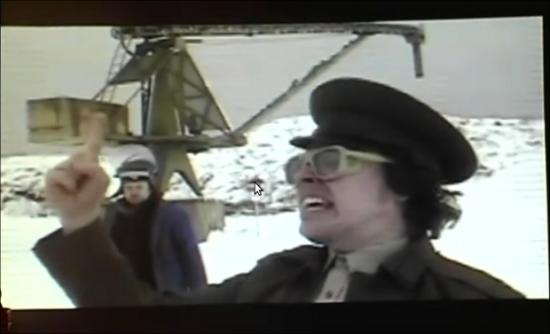
At a HOPE conference a few years back I was interested to hear you talk about the framing of the project as somehow deeply connected with a certain understanding of historiography that you and the other members of monochrom share. Could you elaborate on this a bit?
Debates triggered by postmodern culture have directed our attention towards questions of representation and the relevance of “history” and stories — i.e. The challenging proclamation of a post-histoire, the realization of the impossibility of a meta-narrative of history; the clash between reality and sign systems, the difference between fact and fiction, the impossibility of neutral contemplation or witnessing as well as the positioning of subjective awareness within such representations, etc. All these forms of representation have been playing a central part in the development of national, ethnic and tribal identities since WWII. And (as a by-product of military technology) computer game development is hardly aware of these discourses.
We wanted to combine (retro)gaming and (retro)politics and (crypto)humor to delve into this ongoing discourse. We wanted to harvest the wonderful aesthetic and historic qualities of adventure gaming. It is a commemoration and resurrection, and one more reminder that contemporary gaming (in its radical business-driven state-of-the-artness) should not dare to forget the (un)dead media of the past — or they will haunt them.
If you compare the status of the adventure game in the context of the economic growth of the computer game industry you could state that it is gone. Less than 1% of all computer games written are adventure games. Adventure games are nearly extinct… but only nearly. If media and media applications make it past their Golden Vaporware stage, they usually expand like giant fungi and then shrink back to some protective niche. They just all jostle around seeking a more perfect app.
For many people in the Soviet Unterzoegersdorf team, adventure games are part of their media socialization. For the computer industry it is one of the most successful gaming formats of the past. And for the feminist movement it is proof that a woman — I’m talking about Sierra On-Line’s Roberta Williams — was able to shape the form of a whole industry totally dominated by men.
Computer games are embedded in the cultural framework of technological developments. In the study of technological development and creativity, focusing attention on the failure, the error, the breakdown, the malfunction means opening the black box of technology. Studies have convincingly demonstrated that the widespread inability to understand technological artifacts as fabricated entities, as social and cultural phenomena, derives from the fact that in retrospect only those technologies that prove functional for a culture and can be integrated into everyday life are “left over.” However, the perception of what is functional, successful and useful is itself the product of social and cultural–and last but not least–political and economic processes. Selection processes and abandoned products and product forms are usually not discussed. According to Langdon Winner, there is a sense in which all technical activity contains an inherent tendency toward forgetfulness. Quote: “Is it not the point of all invention, technique, apparatus, and organization to have something and have it over with? (…) Technology, then allows us to ignore our own works. It is license to forget.”
Could you also perhaps talk about the choice of selecting the genre of an adventure game as the incarnation of this downtrodden republic. At the risk of being literal minded, is there any sense in which the existence of ‘Soviet Unterzoegersdorf’ as a kind of place that comes alive through players’ interactions with a program downloaded from the internet has anything to say to how you imagine being able to engage/critique/disrupt the idea of the nation-state?
We are postmodern leftists. A little bit melancholic… but you can count on us. We love to play with layers of consciousness and layers of layers of consciousness. On first view our project could be interpreted as a mock-up of the Soviet Union and the communist state structures that really existed. But, why on Earth do we need so many references to 1980s and 1990s metal music? Or Marvin Minsky? Or Negri? Or Austrian post-WWII history? Or geek adumbrations? Mocking the Soviet State would be much easier. In fact it’s about the wonderful clash between reality and sign systems, the impossibility of neutral contemplation or witnessing as well as the positioning of subjective awareness within such representations. The traditional humanists tend to see the whole philosophic aesthetic postmodern line of thought — from Judith Butler to Lyotard and Derrida — from the wrong angle. Okay, you can’t explain Sun Ra to a Green Day fan now, when he’s laying in the corner, piss-drunk and crooning “Anarchy”. But we think that the (radical) nature of postmodernism is often simply not grasped because people just copy it down into the conservative pattern of thinking which has been indoctrinated into us since the Enlightenment. Of course, on the other hand, it functions as a virus, and there’s nothing wrong with that.
Contemporary art — the field we are usually working in because there’s money — is mostly concerned with systems or systematic concepts. In the context of their work, artists adapt models of individual art-specific or economic or political systems like in a laboratory, to reveal the true nature of these systems by deconstructing them. So would it be fair to say that by their chameleon-like adaptation they are attempting to generate a similar system? Well… the corporate change in the art market has aged somewhat in the meantime and looks almost as old as the ‘New Economy’. Now even the last snotty brat has realized that all the hogwash about the creative industries, sponsoring, fund-raising, the whole load of bullshit about the beautiful new art enterprises, was not much more than the awful veneer on the stupid, crass fanfare of neo-liberal liberation teleology. What is the truth behind the shifting spheres of activity between computer graphics, web design and the rest of all those frequency-orientated nerd pursuits? A lonely business with other lonely people at their terminals. And in the meantime the other part of the corporate identity has incidentally wasted whole countries like Argentina or Iceland. That’s the real truth of the matter.
Read Part 2 of this Interview
http://www.furtherfield.org/features/interviews/interview-johannes-grenzfurthner-monochrom-part-2
Read Part 3 of this Interview
http://www.furtherfield.org/features/interviews/interview-johannes-grenzfurthner-monochrom-part-3
Introduction:
As media attention wanes, the impact of British Petroleum’s Deep Horizon, off-shore drilling disaster continues to unfold. Artists worldwide respond to this new ecological catastrophe in a group show organized by Transnational Temps, an arts collective exploring the interstices of art, ecology and technology. For Andy Deck, one of the founding members of Transnational Temps and the curator of the show, “After a decidedly unsuccessful round of climate negotiations in Copenhagen, the disaster in the Gulf of Mexico frames this exhibition of Earth Art for the 21st Century.”
Now hidden from view by BP’s media campaigns and other de facto censoring actions, the images of oil-covered birds struggling to breathe and fly, oil and dispersant-coated fish, dolphins and whales washing up dead while most sink to the ocean floor, have all but vanished. Partially filling the void are the artists showing here who are recreating topographies: mapping the course of a deadly shadow over our shores and waters; and reinterpreting the sea, its rising levels and largesse, before the vicissitudes of man and nature. Transnational Temps.
———-
Spill >> Forward by Transnational Temps describes itself as an Online Exhibition. It is a website containing images and other media on the theme of oil spills. Some of the images were shown at the MediaNoche gallery from July 30th – November 19th, 2010, with works added or removed so it isn’t just an online catalogue of a meatspace show.
The front page of the site warns that you’ll need a browser that supports HTML5 video and audio, and states that you can view it using patent-free media codecs. From a Free Software and Free Culture point of view this is excellent, your ability to view the art is not restricted by anyone else’s technological or legal machinations. This is also good from an artistic point of view. The software used to view the art can be run and maintained by anyone, making it more accessible, exhibitable and archivable. But this freedom doesn’t extend into the work itself. some of the art uses proprietary software, and none is under a free Creative Commons licence.
The image on the front page, or possibly the image exhibited at the entrance to the exhibition, is not advanced HTML5 video or canvas tag animation but an animated GIF. A Muybridge-ish series of still images of a pelican in flight flickers rapidly up and down as it descends behind an iridescent oil slick that solarizes the bottom half of the image. It’s an effective image in itself, a visually and net.art-historically literate statement that also serves to set the stage for the rest of the show.
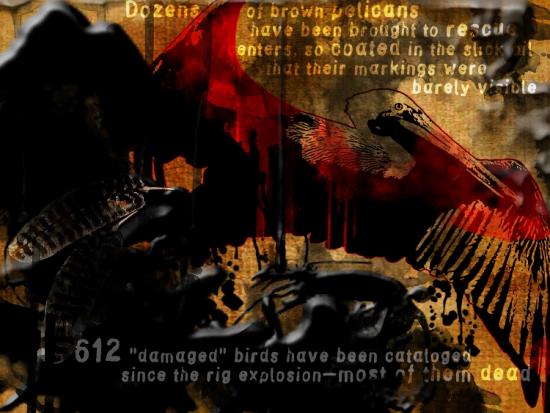
This is clearly a politically motivated exhibition, with the theme of the exhibited art centred on a specific historical event (the Deepwater Horizon disaster). Oil spill and petrol station imagery dominates . The resulting art varies from cooly ironic asethetics (Ubermorgen), photo and video journalism (Guillermo Hermosilla Cruzat, S.Slavick & Andrew E.Johnson, Chris Dascher, Adrian Madrid), agitprop (Eric Benson, Geoffrey Michael Krawczyk, Alyce Santoro, Russ Ritell, Terri Garland, Patrick Mathieu), photography(Jessica Eik, Sabina Anton Cardenal), painting(Jessie Mann), collage(Ume Remembers), performance art(Graham Bell), interactive multimedia (Gavin Baily, Tom Corby, Jonathan Mackenzie, Chris Basmajian, Matusa Barros, Mark Cooley), augmented reality (Mark Skwarek and Joseph Hocking) and drawing (Cristine Osuna Migueles, Adrienne Klein, Jesus Andres, Sereal Designers) to video and audio art (Irad Lee, Luke Munn, Gene Gort, Tim Geers, Gratuitous Art Films, Alex George, Collette Broeders, Fred Adam and Veronica Perales, Virginia Gonzalez, Henry Gwiazda, Maria-Gracia Donoso, Jeremy Newman).
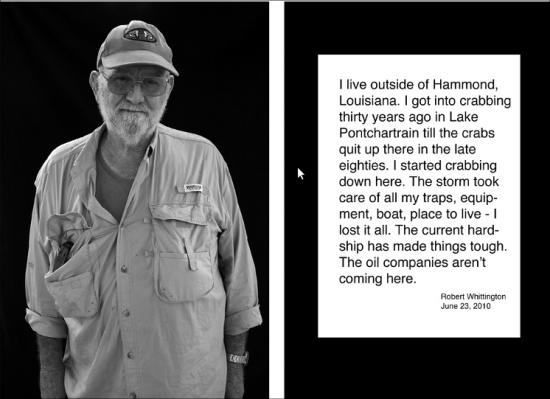
This is a lot to take in but the diversity of the work is a strength rather than a weakness, building a broad and visceral response to the Deepwater disaster. Verbal responses to the disaster from politicians seem unconvincingly nationalistic and corporate in comparison. It might seem hypocritical for artists to criticise the source of the energy that feeds us and allows us to make new media art. But we are trapped in that system, and we must be free to criticise it.
Politically inspired artworks have a difficult history, tending to be either bad politics or bad art. The art in Spill >> Forward is excellent, though. Some has a more direct message than others. Again the diversity of the exhibition plays a positive role here. The immediacy of the agitprop images doesn’t need art historical baggage to be effective, but that immediacy provides a social context for the more contemplative or abstract works. The more contemplative or abstract works don’t hammer home a simple political message but they provide an aesthetic context for the more direct images. They work very well together.
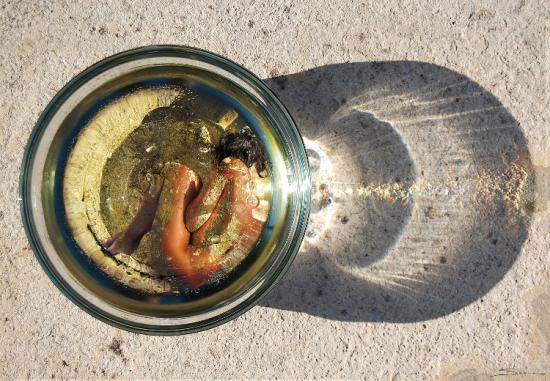
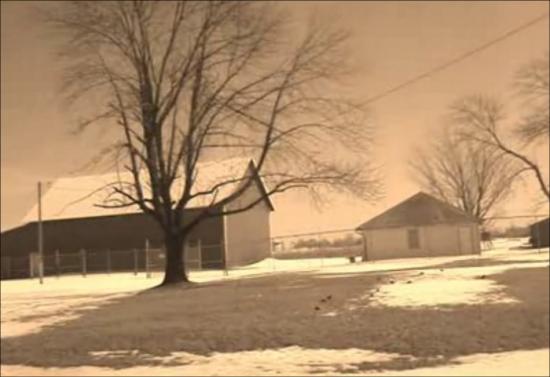
Some of the pieces in the show are clearly illustrations or recordings of work, some are electronic media that can be played on a computer, some are clearly designed to be experienced specifically through a computer system. If you removed the political theme of the show it would still be a visually (and audially) and conceptually rich cross-section of contemporary art. I was going to write “digital art” there but the show includes painting, drawing, performance, and other analogue or offline media recorded digitally for presentation online. The celestial jukebox is hungry.
If I had to pick out just a few pieces from the show I’d say that I was struck by the sounds of Luke Munn’s Deepwater Suite, by the visuals of Ubermorgen’s DEEPHORIZON, by the monochrome images and text of Terri Garland’s photography, by the video mash-up of Colette Broeders’ Breathe and by the critical camp of Graham Bell’s Radical Ecology. I think my favourite is Mark Skwarek and Joseph Hocking’s “The Leak in Your Home Town”, an iPhone app that uses the BP logo as an Augmented Reality marker to super-impose a 3D animation of the Deepwater leak over live video of your local BP petrol station. It is art that could only be made now, technologically, aesthetically and socially.
The aesthetic and conceptual competence of the artistic responses to the environmental and human crises of the oil spills in Spill >> Forward make the case for art still being a relevant and capable answer to society’s need to make sense of unfolding events. Art can still provide a much-needed space for reflection, and Spill >> Forward creates just such a space in a very contemporary way.
The text of this review is licenced under the Creative Commons BY-SA 3.0 Licence.
Ambient Information Systems
English, some texts in German. Translator: Nicholas Grindell
400 pages, 6-colour hardbound, 17.5 x 23 cm
edition of 1,500 unique & numbered.
now available at ambient.publishing.
ISBN-13: 978-0-9556245-0-6
Ambient Information Systems by Manu Luksch and Mukul Patel is a hardback book that presents writing, images and art by and about ambient.tv (Luksch and her collaborators) from during the last decade. Its purple and yellow cover tempered by a tracing paper slip-cover, contains almost four hundred pages of sans-serif text cleanly laid out among images and sidebars. As intermedia artists with a strong emphasis on research and dissemination. Recent works have addressed surveillance, corporate data harvesting, and the regulation of public space.
The material presented in the book ranges from written essays and project proposals through preparatory sketches, computer server log files and video screen grabs to modification of the printed book iteslf by unique rubber stamps and scribbling over sections of text. This diverse and detailed presentation of ambient.tv’s work provides an insight into the inspiration, planning and production of some conceptually and aesthetically rich new media art.
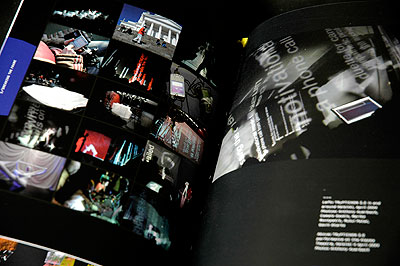
There’s a report from Kuwait during Ramadan 2002, a description of using cutting-edge wearable PCs, a discussion of the role of television, information about the harp in mythology, cyborg markets, the UK Data Protection Act, climate change, anti-gentrification, art and systems theory, UAVs, the Pacific plastic dead zone, and much, much more. There are projects that create free networks, dangerous musical instruments, taped-out surveillance camera boundaries, video installations, photographic images, movies of CCTV footage gained through freedom of information requests, manifestos, snowglobes, and cocktails.
(It’s a fascinating pleasure to read but it’s overwhelming to try and review.)
The portrait of Ambient.tv that emerges from all this is of intensive cultural critique pursued through a playful low-fi digital aesthetic. This isn’t a contradiction, the latter is in the service of the former. Ambient.tv’s projects and proposals tackle serious social and political issues. They do so through skilled use of the aesthetics and attitude of low-fi new media art and technological activism.
The wealth of ideas contained in the essays and other writing in the book show how historical, political and philosophical knowledge grounds the resulting art and indicates how it embodies a critique of contemporary culture.
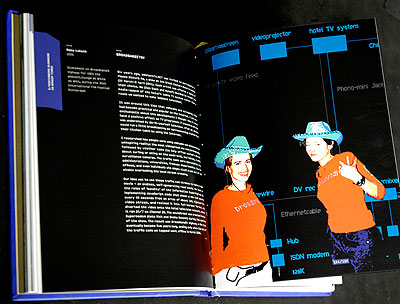
Contemporary culture as seen by Ambient.tv is surveillance culture, the database state with its DNA databases and laws that protect freedom by removing freedom. Ambient.tv is a realistic project, depicting the hidden forms of contemporary society that intrude into our lives. This is heavy stuff, and to air it critically without alienating the audience it requires precisely the playful touch that ambient.tv often bring to their art.
To take the example of FACELESS, 2007, (the first project I personally saw Luksch present), there is an exquisite balance between the disturbing idea of pervasive surveillance, the practical limitations of Freedom Of Information requests, and the visual and science-fictional narrative aesthetic that emerged from this. On their web site it states that it was produced “…under the rules of the Manifesto for CCTV Filmmakers. The manifesto states, amongst other things, that additional cameras are not permitted at filming locations, as the omnipresent existing video surveillance (CCTV) is already in operation.” The result is something more interesting and disturbing to watch than a simple collage of CCTV footage would be. The fact that the work can be made like this, that it can look like this, means something.
This strategy can be seen in “Mapping CCTV around Whitehall”, 2008, as well, which I also reviewed for Furtherfield here, and in many other pieces by Ambient TV.
Reading the proposals and essays shows the depth I suspected to this work, when I first saw it projected in a darkened room is there in its conception and execution.
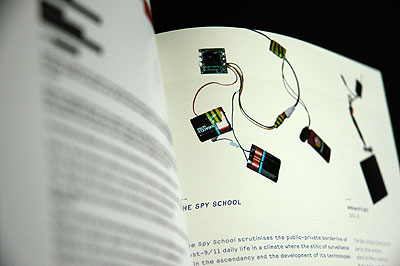
It’s an intense and inspiring experience to be faced with the textual equivalent of a decade-long open studio. The first essay in the book, a theory-laden piece by Fahim Amir, is almost overwhelming in a different way. It’s pure Theory, which will hopefully sell Ambient.tv to the artworld sectors that thrive on that sort of thing, but it isn’t the best introduction for newcomers to the project’s very accessible art.
But what a rare pleasure to be given such a wealth of insight into art that so acutely depicts our times. “Ambient Information Systems” is an important resource for contemporary artists and critics, an insight into the ideas and development of a very successful new media art practice. The grungey, playful, important realism of Ambient.tv’s work deserves presentation in a context that shows just what has gone into the art and just what people can get out of it. This is it.
The text of this review is licenced under the Creative Commons BY-SA 3.0 Licence.
Helen Varley Jamieson’s account of working collaboratively in Madrid at the Eclectic Tech Carnival. On a ‘sprint’, with five women coming together for a week to rebuild the group’s website, physically & remotely.
In the last week of June I went to Madrid for the Eclectic Tech Carnival (/ETC) website workweek – the collective effort of five women coming together for a week to rebuild the group’s website. This is sprint methodology, a concept that I first met in Agile software development, but one that is being increasingly applied as a successful creative collaboration methodology. During the workweek I blogged about the process and this article is an assemblage of the blog posts.
Thinking about the concept of the sprint, I realised that over the years, I’ve participated in a number of theatrical “sprints” although we didn’t call them that. In fact it could be argued that the normal development process for theatre productions in New Zealand is the sprint – a three or four week turnaround of devising/rehearsing/presenting. Except that it doesn’t usually continue the Agile process after the first sprint – evaluation, refinement then the next sprint and iteration – and as a result, the work is often undercooked. But theatre projects that better fit the sprint analogy are some of the workshop-performance processes that I’ve participated in at theatre festivals, where a small group comes together for a few days to create a performance, then some time later meets again in another situation, perhaps a slightly different configuration of people, for another sprint. Each sprint generates a stand-alone performance or work-in-process showing, as well as contributes to a larger evolving body of work that forms the whole collaborative project. Two such projects that I’ve been part of are Water[war]s and Women With Big Eyes (with the Magdalena Project).

Recently I participated remotely in a Floss Manuals sprint, developing a manual for CiviCRM (which is something that I use with the Magdalena Aoteroa site). In this sprint, a group of about 15 people met somewhere in the USA to create a manual for CiviCRM. A few more of us were online, doing things like copy-editing the content. Most of the time there were people active in the IRC channel, chatting about the project and other things going on around them, so I got a sense of their environment, time zone and the camaraderie generated by the intense process.
Sprinting seems like a very logical and effective way to work in many situations: in software development, where each sprint focuses on specific feature development, and allows for a lot of flexibility and adaptation as the project progresses; in theatre, where limited resources make it a practical way to work, and the time pressure forces us to be resourceful and imaginative and also with networks, such as the Eclectic Tech Carnival, whose organisers don’t get to meet physically very often. It also makes sense in the context of our hectic lives, to block out a week or a few days when we agree to put everything else on hold and commit to intense, focused work instead of trying to juggle and multitask, with deadlines pushing out and out.
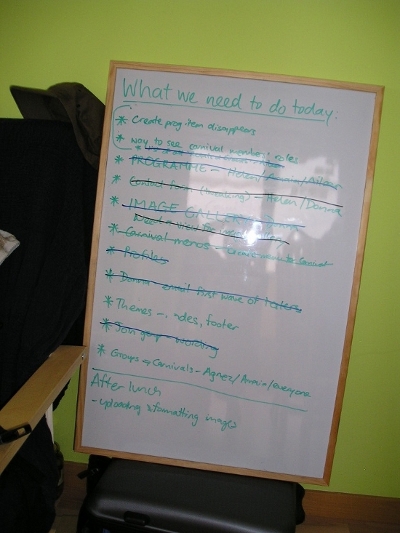
By halfway through the second day of the workweek, the wiki we used to plan and manage the project was filling up with tech specs, user requirements, design ideas, etc. We were getting encouraging emails from others in the network, and chatting to each other across the table and in the IRC. After lunch we did the new Drupal install and things seemed to be moving forward quickly in an organised and collaborative way.
Wednesday afternoon and the heat was oppressive; I put a little rack under my laptop because she was so hot, and my hands were too sweaty to use the trackpad. It wasn’t just Madrid’s weather that was making me sweat – we’d all been working hard on the new site since our late start in the morning (following on from a late night …). Agnes was busy developing the theme for the site, Aileen was working on profiles and user roles while Donna and Amaia were trying to configure mailing list integration and I was using the command line to drush download modules – much easier and quicker than the process of downloading, unpacking, ftp-ing and installing! And very exciting for me to use the command line, which I generally only get to do when hanging out with the /ETC crowd.

We were in that murky middle phase of the process: we’d done a lot of groundwork in terms of defining users, content types, general structure and the functionality required, but everything was still very bitsy and amorphous. But the installation of the test site had happened very easily yesterday, using drush, so that meant we now had something tangible to work with.
Working with Drupal can be pretty frustrating; it seems that every step of the way, another module is required to do what we want – then that module requires other modules, and then every little thing has to be finely configured to work just right with every other piece of the puzzle. From my previous experience with the Magdalena Aotearoa site, I knew we are doing a lot better this time in terms of defining what we need first, but some things we just can’t define until we know what’s possible, which we don’t really know for sure until we actually try it. We *think* we’re going to be able to do everything we want, but getting there isn’t simple. Also, the naming of different components and modules is sometimes ambiguous or confusing – the documentation ranges from really clear and detailed to non-existent. And some things just didn’t seem intuitive to me.
But, with five brains and our different complementary experiences and skills, I was still confident that we would have a new site by the end of Friday; maybe not a completely finished one, but a web site is never finished, is it?
On Friday morning the heat broke with a thunder storm and cooling welcome rain, but it didn’t last long. For some reason I woke up at 7.30am, ridiculously early as we hadn’t gone to bed until 2am. But I was wide awake so I enjoyed a couple of hours of quiet before everyone else awoke, drinking coffee and answering emails. The day before, Agnez and I had got up early to do yoga on the terrace, but the intense rain prevented that on Friday.
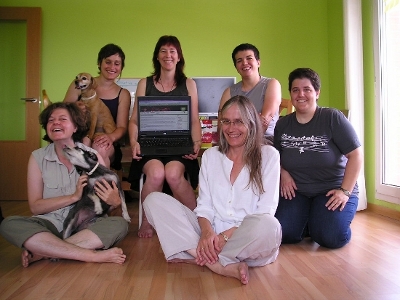
The test site was up and some of the others not present in Madrid were looking at it and trying things out. We’d solved a lot of problems but there were still a number of things not working. I had learned heaps about Drupal in the previous four days, particularly about organic groups, roles, permissions, and views. Altogether it is potentially incredibly flexible and powerful, however it takes time to work out how things need to be done and sometimes it is a confusing and circular process. Changing a setting in one place can stop something in a completely different place from working. However the combination of skills and experience between the five of us meant that usually one of us had at least an idea about how to do things and a couple of times we drew on external expertise via IRC or email.
On the last day, Agnez worked on finishing the theme while Aileen and I tried to work out why our groups are no longer displaying in the og_my view, and how to make the roles of group members visible. Donna had found that mailhandler and listhandler didn’t seem to be a practical way to integrate our mailman lists with Drupal after all – for the time being we’ll stick to the old system – and Amaia had been working on a way to create a programme for each event. The idea is that each /ETC event can be created as an organic group with the organisers having control over content and members within that group, but not being able to edit the rest of the site content. By Friday, we had this working pretty much how we wanted it.
We had planned a barbecue to celebrate the end of the workweek, but the rain prevented that. Instead, we ate inside then took turns to suffer humiliation and defeat with Wii Fitness (Amaia had clearly been practising!). In fact it wasn’t really the end of the sprint – rain again on Saturday morning meant that we decided to keep working longer and only went into the city in the afternoon, for a wander around and then the Gay Pride parade. On Sunday as we began to scatter back to our different parts of the globe, the site was still not live, as we were waiting for more feedback from testers and the finishing of the design themes. However, the site is essentially functional and should be live very soon.
The sprint process enabled us to achieve a considerable amount in a short space of time, sharing our knowledge and developing our skills. We also had great conversations over meals, explored Madrid and Colmenar Viejo, learned how to make Spanish tortilla, attempted a bit of Spanish, went swimming and did yoga. I even fitted in a performance on the first night, with Agnez, and dinner with friends another night. It’s amazing what you can do when you put the rest of your life on hold for a week; the only downside is the catching up afterwards.
.re_potemkin is a crowdsourced re-make of the film “Battleship Potemkin”. It is a “.f.reeP_” project by .-_-., part of a series of projects that embrace the ideology and means of production of contemporary media and technoculture in order to make art.
From December 2006 to January 2007 .-_-. worked with 15 groups of students from Yildiz Technical University to reproduce Battleship Potemkin on a shot-by-shot basis. Not all shots were reproduced, there are empty black sections in the new film. The students and the setting of the university and its surrounds are very different from the locations and actors of Battleship Potemkin. The domesticity, institutional backdrops and modern street furniture would be very different from the 1920s Soviet backdrops of the original even if they weren’t in colour.
Soviet film-maker Sergei Eisenstein’s “Battleship Potemkin” (1925) is a classic of early 20th century cinema, a piece of obvious propaganda that both fulfils and transcends its instrumental purpose with its exceptional aesthetics. Its most famous images have become cultural icons and cliches. If you haven’t seen it then ironically enough it’s on YouTube so you can watch it there and go “oh, that’s where that came from…” before we continue. Or you can watch it in the side-by-side comparison with .re_potmkin on the project’s homepage.
The Soviet dream became (or always was) a nightmare, an ideology that sacrificed many millions of lives in order to maintain its fictions. Our contemporary liberal democratic society regards itself as unquestionably morally superior to communism for this and many other reasons. The (self-)defining difference between Soviet communism and liberal free-market capitalism is economic ideology. Free markets benefit individuals by reducing inefficiencies.
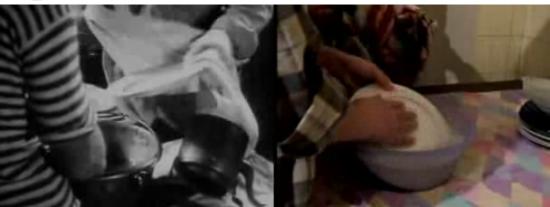
As free market capitalism has triumphed its means of production have evolved. Corporations emerged as a leading way of organizing labour, leading to utopian social projects in the West in the same era as Eisenstein was working in the East and later to a burgeoning middle class in the post-war era. But since then corporations have become increasingly unapologetic exploitative economic projects.
In order to cut costs and become more economically efficient, corporations can become virtual. They shed jobs to reduce payroll and other costs associated with actually employing people. They then source cheaper labour and production from outside, paying other companies to make the branded goods that the corporation sells. This is known as outsourcing.
A logical next step in corporate cost reduction is to source labour from individuals without paying for it at all. This is known as crowdsourcing. Although individuals who donate their labour to a corporation through crowdsourcing might not be compensated monetarily, they can still be compensated in other ways.
With crowdsourced intangible goods the best way of rewarding people who donate their labour to produce those goods is simply to give the resulting product to them under a licence that allows them to use it freely. Non-profit projects such as GNU and Wikipedia do this very successfully, but corporations are always tempted to try and privilege their “ownership” of other people’s work. Where crowdsourced labour is exploited without fair compensation this called sharecropping.

.re_potemkin is a non-profit project rather than a corporation, and as such it has adopted a GNU or Wikipedia-style copyleft licence. Or at least it claims to have. In a creative solution to the fact that there is more than one copyleft licence suitable for cultural works, .re_potemkin’s licence is a kind of meta-copyleft. Checking the licence page reveals that .re_potemkin’s licence is more a licence offer than a licence.
This avoids the politics of imposing a choice between competing copyleft licences on the producers and consumers of the work. The only problem with this approach is that adaptations of the project, works that build upon it, may end up unable to be combined and built on further because they have been placed under incompatible licences. This is unlikely to happen, but it can be very frustrating when it does.
.re_potemkin is crowdsourced equitably, then. And even in its technical form, .re_potemkin is a free and open resource. it is distributed not in a patent-encumbered, proprietary format such as Flash or MP4 but in the Free Software Ogg Vorbis format. Too few artistic projects follow the logic of their principles in this way, instead sacrificing principle to the at best temporary convenience of the proprietary YouTube or QuickTime distribution channels.
The politics of the production of an artwork are only of aesthetic (rather than art historical) interest if they intrude into the finished artwork. A crowdsourced artwork such as the Sheep Exchange is about crowdsourcing as well as being made by it. The aesthetic of that work (many differently styled drawings of sheep) raises the question of how and why it was produced and this feeds back into the aesthetic experience.
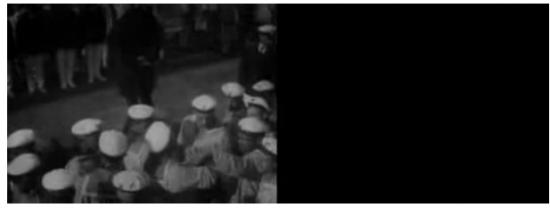
.re_potemkin does not follow the classic crowdsourcing model of an open call for volunteer labour on the internet. It was produced by many groups, but in a closed community. It functions more as an allegory of crowdsourcing than as a literal example of it, but this adds to the project artistically, creating a layer of depiction. The means of production are aestheticized in a way that presents them for the viewer’s consideration in way that can be understood and contemplated more easily than an amorphous internet project.
The “commons based peer production” of free software and free culture is not, to use Jaron Lanier’s phrase, “Digital Maoism”. But the comparison is a useful one even if it is not correct. Utopianism was exploited by the Soviets as it is exploited by the vectorialist media barons of Web 2.0 . re_potemkin gives us side-by-side examples of communism and crowdsourcing to consider this comparison for ourselves.
Within the work the similarities and differences between the original film and its recreation vary from the comical to the poignant. Students in a play park acting out shots of soldiers on a warship, hands placing spoons on a table cloth, crowds gathering around notice boards. This isn’t a parody, it’s an interrogation of meaning. And it is a strong example of why political, critical and artistic freedom is at stake in the ability of individuals and groups other than the chosen few of the old mass media to organize in order to refer to and reproduce (or recreate) existing media.
The text of this review is licenced under the Creative Commons BY-SA 3.0 Licence.
Featured image: F.A.T. Lab (Free Art and Technology Lab) were found causing trouble at the Transmediale.10 this year.
An interesting outsider project at Transmediale.10 this year, was F.A.T. Lab (Free Art and Technology Lab). A collective of artists, engineers, scientists, lawyers, musicians and trouble-makers who have been working together for two years, on the intersections of Pop culture and Open source. Their stapline describes them as “An organization who is dedicated to enriching the public domain through the research and development of creative technologies and media”. Beware, they love using the word ‘Fuck’. A lot! Which means they are cool, and some you grown ups may feel slightly unnerved by their over generous outpouring of flippant explitives, but the kids out there just love it!
You can read an explanation of their work in the about section on their website, and view a video presenting some of their ideas and works. With a simple rap base with nasty yellow and pink colors, it could be considered as a joke. Perhaps, to some degree it is, but at another level they are playing around with social contexts of the Internet culture’s, presumptions and acceptance of things. Through an omnipresent ludic approach they reuse what is given to us all with a contemporary pop attitude – showing us the many contradictions from these given systems. Proposing other possibilities in order to loosen and to free things up from the copyright laws and prescribed rules of both big companies and clumsy governments.
One of their projects called Public Domain Donor, consists of D.I.Y stickers saying “In the event of death please donate all intellectual property to the public domain”. They write “Why let all of your ideas die with you? Current Copyright law prevents anyone from building upon your creativity for 70 years after your death. Live on in collaboration with others. Make an intellectual property donation. By donating your IP into the public domain you will “promote the progress of science and useful arts” (U.S. Constitution). Ensure that your creativity will live on after you are gone, make a donation today.”Simple and humurous.
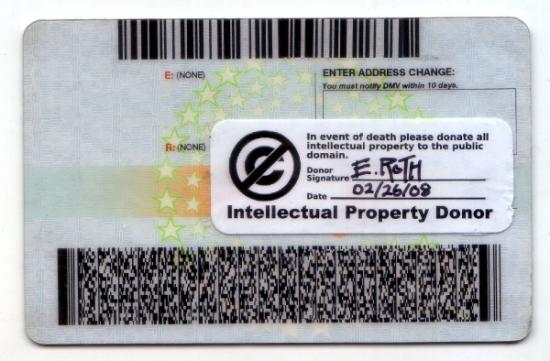
Yet, behind their process of cultural detournment exists a reference to earlier net art critique, by Critical Art Ensemble who way back in 1995 said “Each one of us has files that rest at the state’s fingertips. Education files, medical files, employment files, financial files, communication files, travel files, and for some, criminal files. Each strand in the trajectory of each person’s life is recorded and maintained. The total collection of records on an individual is his or her data body -a state-and-corporate-controlled doppelganger. What is most unfortunate about this development is that the data body not only claims to have ontological privilege, but actually has it. What your data body says about you is more real than what you say about yourself. The data body is the body by which you are judged in society, and the body which dictates your status in the world. What we are witnessing at this point in time is the triumph of representation over being. The electronic file has conquered self-aware consciousness.” The Mythology of Terrorism on the Net. Critical Art Ensemble Summer, 95
Also as stimulating, is the idea Graffiti Markup Language, an XML file type specifically designed for archiving graffiti tags, and easily reproducing them.
For Transmediale.10 they presented a project called Fuck google, one of their more involved works, appropriating the image of Haus der Kultur der Welt, the futuristic bulding hosting Transmediale, formerly known as the Kongresshalle conference hall, a gift from the United States, designed in 1957 by the American architect Hugh Stubbins Jr. as a part of the Interbau exhibition. John F. Kennedy spoke there during his June 1963 visit to West Berlin. Fuckgoogle focuses on reminding us all how this big company has become omnipresent in our digital lives, refering to the risk that too much data is owned and is going to be owned more and more, just by Google alone. It exists as a collection of browser add-ons, open source software, theoretical musings and direct actions.
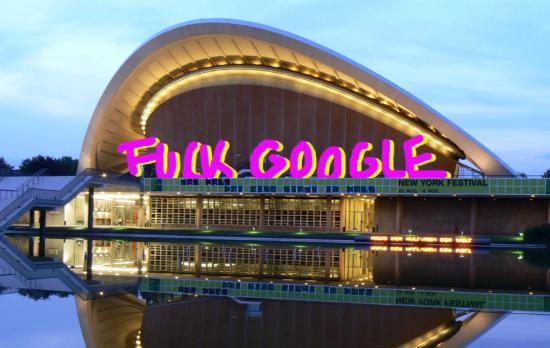
Not necessarily trying to be a definitive solution against the big G in any sense of the word, but more a reminder, a provocative virus to diffuse. So we have a graffiti firefox skin, fuck google pins, The F.A.T Pad or some plugins to reclaim your public individual space on your browser. Everything is D.I.Y and opensource, so you can easily replicate it. The approach can be find with FuckFlickr a free image gallery script offering everyone who visits a Flicker-like image gallery.

The F.A.T. Lab is an example of technological sabotage. Of course, it’s not a new thing in respect of the hacker community: using the instrument, medium directly, in order to change perceived assumptions of our reality. What is quite new is F.A.T. Lab’s blatant exploitation of everyday Pop culture and its language. The hacker counterculture has always had it’s own way of communication, built in the late 80’s and 90’s. These days, more and more people use the computer, not just hackers. Using Pop culture in order to communicate one’s message could be one possible way to escape the duality culture/counterculture. On the other hand, F.A.T. Lab could be creating a fresh paradigm which allows others who would not normally appreciate hacker culture or even media art culture, filling a space beyond art culture which could be considered as too refined.
Marcello & Gaia: Can you describe who you are and how do you connect each other?
Evan Roth from F.A.T. Lab: We are a group of friends. There’s not any formal application process or open call, many come from typical art organizations. It started out as a group of friends and then slowly, more friends joined. We also made more friends, collaborators on line. Here at Transmediale.10, it’s actually our first chance to meet face to face and some of us have not met before. There are two things that mainly characterize us. On one side, there is the open source culture and advertisement free culture, but also the idea that this all should be fun. Art and political activism doesn’t have to be a boring, the interface of it all, can be accessible to more people. We try to push this candy coding, get the those audiences who are using youtube videos, that is our primary audience. We like it when art organizations pay attention to us but really our main audience is at the borders of things, using different networks, commercial networks out there, happening outside of the gallery.
M&G: If we look at the projects you are showing here there is a kind of aesthetic in common, the colours are really interesting, the pink and the yellow remind us early 90’s spam. Is that aesthetic a primary decision, is the style you choose to define you, or has it just happened in the progress of your work.
E: I answer that in two. There is a thing from open source development culture that is ‘release early and release often’, we try to apply this model to the media production. We try to release ‘early and often’. If you are on the fence where you should release something or not and it is not quite ready, just push out the door, because it is better to have it in the public counter system than not. So the aesthetic of the website is in part probably pushing out the door rather taking care of the nuances or the color it is. We just try to get this thing published quickly. Someone could be sitting on their brilliant idea and waiting for years to release, waiting for some details and then you find that no one really cares about this in the end. But there is also an aesthetic interest in common, that comes from this ‘dirty style’. There is an artist friend, Cory Arcangel who is one of my favorites, and he describes the dirty style as ‘either you take little interest in design so it becomes so un-aesthetic or you over-work it to a point that the work itself becomes something too trivial’. We don’t have meetings about how the website is going or what it looks like.
M&G: Don’t you think that this “dirty style” is somehow hiding the real content or the message? The use of ‘dirty style’ is obviously an answer of the hyper sensibilization, concern of the form but at the same time this makes your work splitting in between the no-attention of form and pushes content in the corner.
E: The way our websites look matter’s less and less now, because people don’t go to websites for content anymore. Most of the traffic in the websites do not even see the pink and the yellow, design. There is some kind of form/function relationship going on. We are interested in rolling up this web 2.0 idea a little bit, and that’s what this installation here is about at Transmediale. The early 90’s aesthetic was with people hand coding html and making tables, not downloading a WordPress thing. In that sense, there is a sort of connection to the DIY, rolling back to the way of 1.0 – where the files are hosted in your own server and not google or yahoo.
M&G: Isn’t it more interesting to try and critique in a more constructive way, creating something else, not just another google appropriation but other kind of net platform for a community? Could that be one of the important challenges for artists now?
E: Open source is a big movement and free culture is even bigger and so we know that there are people out there hacking in this way right now, but we are not programmers, there are programmers taking part but these are not our skills. Our place in this movement is in the media side. We do have programmers in our group but we feel more like media makers. We make these videos and they are kind of funny and taking something from the pop/culture, twisting them, possibly people have a look and pass them around. But there are messages in them. And the messages are trying to reveal the money and the branding business that google is making and saying it is not cool, and being involved in an alternative open source culture looks better. We also have a development tool like fuck flicker and flv player where you can have your own videos up like you tube.
M&G: Why are you are supposed to win this year’s Transmediale? You stood up on the stage during the award claiming the award for yourselves!
E: Oh no, we don’t think we are supposed to win. Do you know Kanye West? This is a USA story, we joked about Kanye a little bit. We’re always trying to pay attention to what is going on in pop culture and surf a little bit. Kanye was notorious for interrupting a ceremony whenever he lost, grabbing the mic. As we were for this fuck google project – last night, the winner was a youtube related project, and google is a sponsor. The message we tried to get across last night, was a reference to this, and we are gonna have an official press release on it soon. But I think that for Transmediale, our project was an anomolie, showing this fuckgoogle in contrast to accepting web 2.0, which is actually a range of projects. We were surprised to be invited, who know’s what for? But we think that it was a very wise decision, and we are really happy to be here.
On their website you can get a clear impression of their feelings towards Google “So, what is so “fuck-worthy†about Mother-google? It is the fact that a corporate entity, even one as beloved and competent as Google, is in control of such a large stake in the digital network and public utility upon which we have all grown so reliant. And, that as a publicly traded company, it doesn’t have to answer to anyone but its largest shareholders, despite the fact that its decisions effect the lives and private information of millions of people. Few even question or raise a voice in opposition to the Google-ification of the Internet.”
There were more than 1,500 submissions for the Transmediale.10 awards, nine art projects were nominated and F.A.T. Lab was a runner up amongst them. Showing contemporary, activist art within a larger more incorporated festival is to be commended, it is not an easy thing to do. And we all know how easy it is to criticize rather than make something ‘real’ and positive happen. F.A.T. Lab are a tangible byproduct of a culture, caught in the trappiings of Hyperreal situations, a confused world losing itself even further into a perpetual state of denial. Pop culture and celebrity related banalities are constantly distracting our gaze. It is an interface which can only handle life via mediated proxy. F.A.T. Lab know’s this, and have adapted themselves to literally scrap with it on their own terms. Their role and place in the world is to get out there on the front line and go places where the common people reside. They want to be on the main stage battling it out, whilst challenging the interface presented to us all – making it their playground.
You can also read Marcello Lussana and Gaia Novati’s article about this year’s Transmediale.10 here…
Featured image: Photograph of a creative experiment on more intelligent modes of inhabiting the planet
Open_Sailing‘s biggest achievement is perhaps to have turned our future into an open source project. Led by a group of enthusiasts, gathered around the idea of “we don’t know what will happen, but together we can invent our future and cope”, the project puts forward a very ambitious, action-driven, experiment-led, way of thinking forward. After meeting with the founder of the project, Cesar Harada, Open_Sailing proved to be a much more complex enterprise than I originally thought.
Initially the project started by mapping threats, the idea being that threats can produce something else than fear. Indeed Cesar Harada, was decided to turn threats into design constraints. This constitutes an interesting methodology to deal with the current climate of fear. The exploitation of threat has become the standard procedure to stabilize a permanent state of emergency. Mobilising virtual threats, states acquire exceptional powers that facilitate the implementation of ever more pervasive measures of control. The current case of swine flu is the last of a long list of exercises of mass modulation of fear. War on terror is the paradigmatic one. On the other hand, and following the warnings of the Maya calendar, all sorts of popular tales for an apocalyptic 2012 have started to populate the planet.
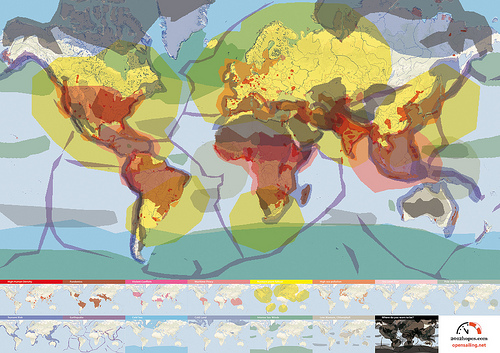
The role of Open_Sailing is to function as a catalyst that channels all this energy into the production of a better future. In short, its role is to transform fear into hope. Certainly this functioned as a strong attractor for new collaborators and soon the team started to grow. After putting together large amounts of real-time data about all sorts of dangers such as tsunami, terrorist attacks, nuclear accidents or pandemics, it became clear that the potential safest spots on earth were mostly located at sea. That led to the idea of designing the infrastructure necessary to inhabit those spots based on the concept of ‘Open Architecture’. Fear had been successfully turned into an active force unleashing the creative process. Inspired by this initial concept the Open_Sailing team started a very intense process of scientific, technological, architectural and artistic research that resulted in a first prototype awarded at Ars Electronica: Open_Sailing_01.
“A drifting village of solid and comfortable shelters surrounded by flexible ocean farming units: fluid, pre-broken, reconfigurable, sustainable, pluggable, organic and instinctive.” [1]
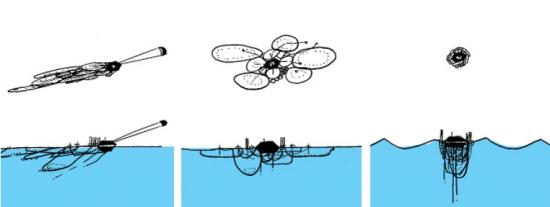
This drifting village, which is about 50 metres in diameter and can host four people, is designed to respond to its environment, being able to become compact and endure severe weather conditions, and spreading out to harvest in calm situations. Open_Sailing_01 was supposed to set sail last May 2009 but mis-coordination in the production with Ars Electronica delayed the plan. In the meantime, small intermediary prototypes of different modules are being built and tested constantly, but the Open_Sailing team hopes to put together the main modules of the International_Ocean_Station for general testing by the summer 2010.
One other important thing that came across in the interview with Cesar Harada was how soon after Open_Sailing was set in motion, it became clear that the project was not only about escaping the problematics of our society. It was definitely not an idealistic utopia happening elsewhere and starting a world from scratch. Rather than an exercise of escapism, they realised that the idea of inhabiting those sites where there is no threat had become an experimental laboratory where to grasp the future. Indeed Open_Sailing is very much about finding ways to face and deal with the very problems of our world.
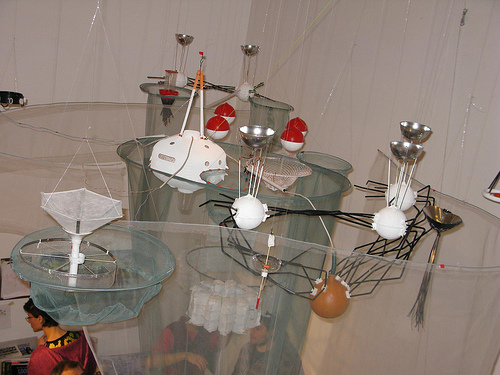
“Be it overpopulation, global warming or energy conflicts, we are living in a time where ‘Apocalypse’ beckons. We need to collectively invent and spread bootstrapping DIY technologies for the forthcoming challenges, not only to survive but to re-invent how we inhabit this planet.” [2]
This became particularly obvious when the team flew to Morocco to try out some live-saving structures. Between the coast of Morocco and the Canary Islands in Spain hundreds of illegal immigrants die every year at sea. A high-seas permanent shelter would provide a low cost life-saving facility for the migrants.
This particular instance is also paradigmatic of the way in which experimentation is carried within the project. Future thinking is developed through material instantiations. This very characteristic process of design and engineering disciplines gives Open_Sailing an exciting palpability, a materiality, a commitment with actualisation that accounts for its potential to bring about real change. Commitment with results drives the project away from the artistic disciplines, but the poetics of the project undeniably brings them back together. A project that in a year of development has acquired such a level of complexity necessarily had to go through a very intense and accelerated process of conceptualisation and experimentation. And there comes the figure of the enthusiast, an experimental survivalist who is willing to take a plane the morning after an idea has come up to participate in a military training testing life-saving technologies.
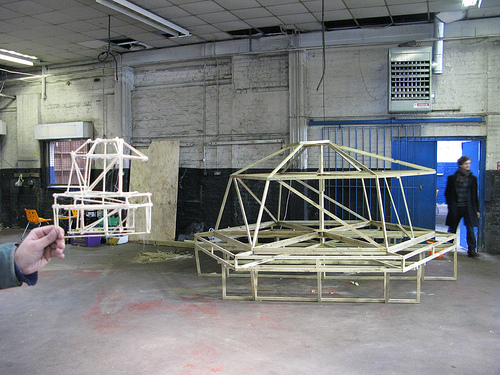
Even more interesting is perhaps how this enthusiasm becomes contagious and the project starts to work as a truly open source venture. Open_Sailing becomes a powerful autonomous entity that keeps bringing people in a dividing itself into labs. Each new lab engages a whole new group of contributors, with a new set of preoccupations and hopes. The project proves to be definitely not about the implementation of a master plan or utopian blue print, but an example of how open source can literally be applied to the construction of alternative worlds. Within these labs we find different experimental research projects focusing for example on mesh networking; pollution, climate and natural reserve monitoring; sustainable aquaculture in high seas; or energy autonomous systems that generate electricity through wind, sun or wave power.
Now, there is of course the problem of co-option. The research being done is a very useful material with infinite commercial and even military applications. But perhaps this is not something that compromises the success of the project. Rather, its value lies in its capacity to encourage people to co-design their own futures. It is more about joining people that want to create than attracting those that want to buy. Surely, it is the process of creation of alternative that’s been set in motion that is truly significant, even more than the technologies being produced. Furthermore, Open_Sailing manages to reverse the process of co-option, the same way it reverses the effects of threat. Collaborators turn to scientific institutions, corporations, military research, as a useful resource, and then open up the knowledge acquired. This is not a new ‘green design’ product for the consumerist society, it is a spark for a collaborative rethinking of the world.
“Mapping CCTV around Whitehall”, 2008, is, as its name implies, a performance of mapping Closed Circuit Television (CCTV) security cameras around the UK’s parliament in London and a video record of that performance by Ambient.tv’s Manu Luksch.
Starting with a HAL 9000-like image of a CCTV lens, the video of “Mapping CCTV In Whitehall” has a glitchy techno aesthetic of sound and images with a post-MTV-Style Guide reportage feel. The first half consists of a recording of the police stop-and-search interviewing Luksch under anti-terrorism legislation, with a map of the area superimposed. The second half consists of CCTV views of the range of Camera number 40 being taped out, and of the people caught within those bounds. Words flash on the screen to identify the subjects of CCTV (….Artists! Sexy Arses!). This redeployment of the language of mass media visual persuasion opens up what we see rather than closing it down, making it a very effective encapsulation of the project’s ideas and aesthetics.
(One tiny criticism is that the video ends with a Creative Commons logo but doesn’t specify the licence. Artists, please at least give the licence URL, and do choose the copyleft BY-SA licence if you can…)
Wandering around to locate CCTV cameras may seem like a cosy techno-fetishist performance, a post-cyberpunk flaneur’s stroll around the streets of London with a pencil, an A-Z, and a tri-field meter. But the creeping authoritarianism of still-Thatcherite Britain makes it an act of protest against a specific law and a reversal of the assumptions of our seemingly unstoppable surveillance culture.
The Serious and Organized Crime and Police Act of 2005 criminalized political expression within an exclusion zone for a kilometre around Parliament Square. It is an indicator of the authoritarianism and assumption of privilege that has come to define political culture in the UK. It is too easy to become cynical in the face of such brazenly opportunistic ideology. If art can help to defamiliarise this in a playful and aesthetically rewarding way then it can help to undo that cynicism, and even more to go beyond it.
The assumption that the State needs to know where you are at all times, just in case you are a terrorist or a paedophile, but that you must not know the workings of the State, just in case you are a terrorist or a paedophile, is at odds with the idea of an open society. The area of London that Luksch has mapped is the SOCPA exclusion zone. A map of CCTV cameras is clearly useful to terrorists, and a map of the CCTV cameras near Parliament is clearly an act of dissent against the political consensus that constitutes domestic extremism. The police who interview Luksch touch on these ideas.
A political elite that is fearful both of and for its polity has retreated into managerial, authoritarian, paternalistic risk-management. That polity is conceived of, post-cold-war, not even economically, more nihilistically. This produces the very loss of freedom that it claims to protect against. The paradigm of government has become the watchful parent who is seen to be good by their watchful neighbours because they prevent their child ever straying into danger. But it is impossible to protect the population against all risk and this knowledge leads to impotent fearfulness. “Something must be done” and so security theatre, the spectacle of impossible systems and behaviours designed to reduce the perception of risk to zero, is used to reassure. Although whether the populace or the politicians are meant to be reassured it is hard to tell.
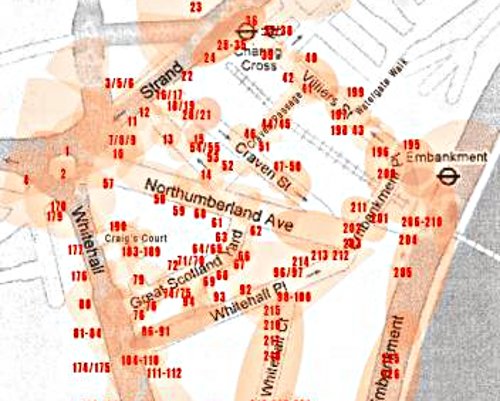
CCTV is part of that reassurance, of the spectacle of security theatre. The UK has the highest density of Closed Circuit Television Cameras (CCTV) in the world. The average Briton is (allegedly) captured on CCTV 300 times a day and there are more cameras in the supposedly open society of the UK than in notionally communist China. Not per head, in total. The area that “Mapping CCTV around Whitehall” focusses on is ground zero for this tendency.
CCTV doesn’t solve crime, it is used to spy on legal protest and it has been placed in school classrooms and pubs.
CCTV recordings are subject to the Data Protection Act, and from 2002-2008 Manu Luksch used personal data requests under the act to obtain the CCTV recordings of her going about her business that she used to make the film “Faceless”. The videos usually had other people’s faces blotted out to protect their privacy, which gave the resulting film its science fiction plot of people starting to lose their faces. But as Luksch was making “Faceless”, the responses to her personal data requests became rarer as the authorities adjusted the balance of power back in favour of themselves.
In 2008, Luksch returned to the subject of CCTV with “Mapping CCTV around Whitehall”, this time mapping out the CCTV cameras themselves within a particular area of London over two days. On the first day she located hundreds of CCTV cameras, on the second she measured the range of the wireless broadcasts of one of them. Part performance, part land art, this has a number of artistic precedents, from the 1960s conceptual artworks that consisted of magnetic fields or patterns of heat, to Situationists strategies for recontextualising the city by navigating it using the wrong map.
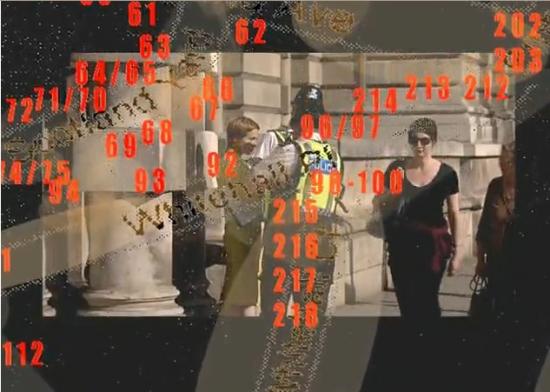
Mapping unseen electromagnetic forms was a strategy of some Conceptual Art, whether Art & Language’s landscape art infrared photograph of buried hotwires under a field or gallery-based magnetic and radio-proximity devices. Contemporary artists have used RFID tags Intangible form is irresistible for post-Duchampian attempts to keep the philosophy of art about aesthetics, and for conceptualism it is a way of keeping the artwork open. But the range of a CCTV camera is both definite and, if you have access to the camera, visual. The unseen form of the limits of its observation and the transmission of what it sees tie form to power quite directly.
In “Mapping CCTV around Whitehall” these forms and their composition are part of the landscape of the city. The city is obviously an artificial environment. In contrast, nothing might seem more natural than a painting of the landscape of the countryside. But landscape painting are depictions of valuable property for the landed gentry who commissioned them. They show and by showing make real the products of the ideology of the ruling class using aesthetics. They extend the domain of taste, a novel and socio-economically exclusionary concept, to the presentation of nature as property. They are as artificial, as culturally determined and laden, as cityscapes.
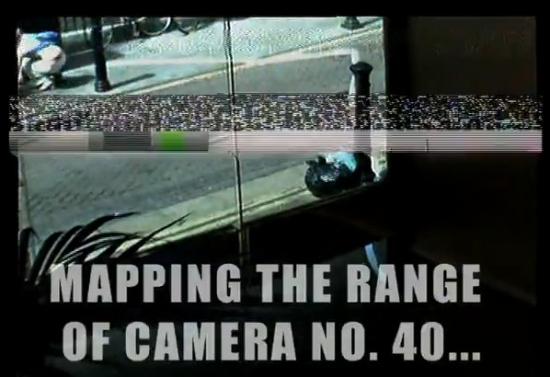
The successor to landscape painting is the “land art” of the 1960s and 1970s with its photographs of walks, mud and stones. Viewed cynically, the ‘land art’ of the 1970s is less about one man’s journey through nature than it is about cheap transport and expensive large-format cameras. It is a predecessor of the logistics art of Relationalism. The Romanticism that it shares with landscape painting is for its audience, not its commissioners. As with much art, those are two separate constituencies.
Art creates visual order and visual form for the unseen ideological order and form of the ruling class. Religious icons, jet-age land art and neoliberal Relationalism all serve this function. Critical art also depicts this ideological order, ideological form, aesthetically but to make it strange and criticise its production or content rather than to promote and naturalise it.
The Situationists treated Natopolitan 1950s Paris as a landscape to be made strange through art in order to critique the ideologies that sought to capture its population. Wandering its streets using the wrong maps was a way of challenging the authority embedded in its layout by the old regime and the new order that sought to impose its own new way of looking at things. Creating rather than using a map again re-arranges an equation, not just the equation of ‘derive’ but of the mass-media mass-politics spectacle that the Situationists were so opposed to. CCTV cameras may not seem like generators of spectacle, but their footage is used to sensationalise media reports of crime and terrorism, and their presence and visibility enforces the message that we are all part of an observed spectacle.
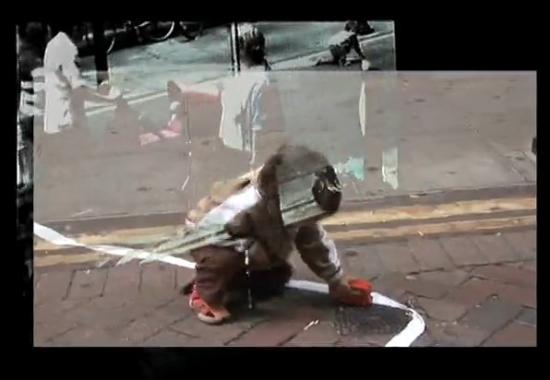
Radical land art sounds oxymoronic. But the aesthetics projected onto a landscape can be used as links to the ideology flattered by those aesthetics. And re-arranging the terms of land art can critique that ideology, or at least expose it to critique. “Mapping CCTV around Whitehall” re-arranges the equation of land art to make art of travelling to cameras in order to map the landscape they observe. This is a kind of critical, urban, reverse land art.
George Orwell’s vision of a mediatised totalitarian society from his novel “1984” is often used as a reference point for Britain’s surveillance culture. But this can obscure as much as it illuminates. Bringing out the true, novel, problems with CCTV surveillance as the default solution to the ruling class’s perception of society’s ills is an urgent and difficult task. As CCTV is a matter of the production and control of images, it is an area that art can usefully comment on. “Mapping CCTV around Whitehall” uses the status of art to represent the dark heart of surveillance ideology. Look upon its works…
http://ambienttv.net/content/?q=mappingcctv
Public screenings include ‘Films by Manu Luksch’ at Cinema2, Centre Pompidou (2009)
Betting on Shorts (2009)
http://ambienttv.net/content/www.bettingonshorts.com
NHK Japan (Japanese National Television, 2008), LIFT (2008)
Watch the video (160 sec, mp4) online at low-res.org
http://lo-res.org/~manu/MAPPINGCCTV.mp4
Or on Vimeo
http://www.vimeo.com/3802118